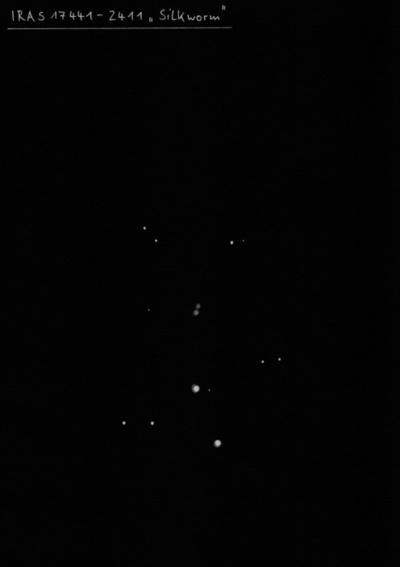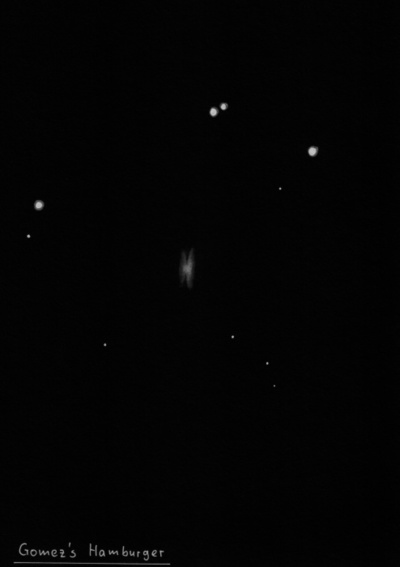A large and very rich in bright objects zodiac constellation in the southern sky between Scorpio and Capricornus. Especially in North America, the striking pattern of bright stars, none of which exceeds 1st magnitude, has been named "Teapot" after its shape. It consists of a group of eight stars, γ, δ, ε, ζ, τ, ρ, π and λ Sagittario. The Sun passes through Sagittarius from December 18 to January 19, at the time of the winter solstice. The best time to observe the objects of this constellation is therefore in summer. However, it lies far enough south that its southernmost parts do not come into view for us, and the very centre of the Galaxy is only a few degrees above the horizon, so we are deprived of some fantastic views.
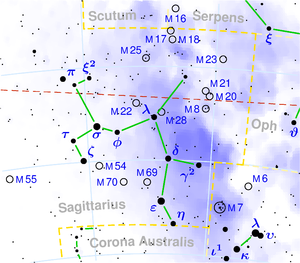
The most important fact about the constellation Sagittarius is that in that direction, at a distance of 27,000 light-years, lies the core of our Galaxy, and in front of it, one of its spiral arms, the Arm of Sagittarius. The exact position of the centre is identified with the position of the Sagittarius A radio source and is given by a rectangular value of 17h 42.5min and a declination of -28˚ 59'. In the sky, this point is about 4 degrees WNW of the star γ Sagitttario. However, we will never see it within the distance of the galactic centre because it is obscured by the huge clouds of interstellar dust lying along the spiral plane of our Galaxy. Astronomers have estimated that stars in the region near the galactic centre are dimmed by up to 27 magnitudes! The brightest visually visible star clouds are therefore located a little further north and east, and represent a kind of cross-section of dark dust clouds.
This is exemplified by the Milky Way's most extensive and brightest cloud ever, the Large Cloud in Sagittarius, visible in part on clear, clear nights perhaps even from our latitudes. It is part of the central bulge and is practically the most distant structure in our Galaxy that can be seen without a telescope. The faintest stars of the cloud lie about 20,000 light years away. In the sky, the cloud has an elongated shape with an average width of about three and a half degrees and a length like the conjunction of the stars μ Sagittario and λ Scorpii. While it is always a bit of an exaggeration to talk about distinct colours, note that it has a yellowish tint. To the west of the Great Cloud there is a dark band with intricate edges about one and a half degrees wide, extending from the boundary with the constellation of the Serpent to the tail of Scorpius. In some places its boundary is sharply defined; in others it passes smoothly into its surroundings, and the exact limits are difficult to determine.
In the immediate vicinity of the Great Cloud two conspicuous oval nebulae are visible to the naked eye - the Laguna and Trifid nebulae. One of the most interesting places in the entire Milky Way is hidden behind a very distinctive brightening in the form of the Small Cloud in Sagittarius M24. It lies in a milky region about five degrees in width, running north from the Large Cloud towards the Shield, which merges smoothly into its surroundings on the west side and contains several small dark bays on the east. M24 represents only a very small part of the structure of the spiral arm of the Ruler, which, together with the Sagittarius arm, forms the two main spiral arms of our Galaxy. It starts near the galactic center about 10,000 light-years from the Sun, rotates around, disappears behind it, and only appears after the Perseus arm. M24 is more than easy to find in the sky about two degrees north of the star μ Sagittario because it is a very conspicuous object. In the binocular it is seen as a hazy white region of uniform brightness and 1x2 degrees in size, from which a few faint stars stand out. It is most conspicuous and contrasted in its eastern part, and best delineated along the southeast, northeast, and northwest sides. In addition, a pair of textbook dark nebulae, Barnard 92 and 93, are located in close proximity. South of M24 lies a small but conspicuous dark smudge and a cluster of stars 15, 16 and 17 Sgr that cannot be individually resolved. The environment is finally completed by another blurred circular spot half a degree in diameter, the open cluster M25 (4.6mag).
The arm of Sagittarius continues southward through the constellations of Sagittarius and Scorpius to the constellation of the Ship's Keel. Most of the famous and beautiful nebulae or star clusters that can be seen in this part of the sky are therefore located in this arm. It includes a large molecular cloud, on the edges of which we observe the well-known emission nebulae M8, M16, M17 or M20, the open clusters M18, M21 or the association around NGC 6231. It also includes, for example, the star cluster NGC 6193 from the Altar, the nebula Eta Carinae from the constellation of the Ship's Keel or the Jewel Box in the Southern Cross.
Kaus Australis (ε Sgr) - The brightest star of the constellation (1.85mag) is located in the southern part of the arc and reaches a maximum height of 7 degrees above the southern horizon at its culmination. It has a white color. It shines as bright as 250 Suns from a distance of 125 light years. It is also an optical double star, with a companion of seventh magnitude located about 3.3 arc minutes to the northwest, which can also be observed with a telescope.
η Sgr - Easily observable double star: the magnitudes of the components are 3.2 and 7.8 and they are located at distances of 3.6". The brighter component is red-orange, while the fainter one is white. At a distance of 93", there is a 10th magnitude star, and at a separation of 33", there is a 13th magnitude star.
Arkab (β Sgr) - Wide optical double star suitable for observation with a refractor. The primary component has a magnitude of 3.9, and additionally, there is a companion of magnitude 8 located at a distance of 28.4".
21 Sgr - unequally bright and contrasting double star of orange (4.9mag) and bluish components (7.4mag), which are separated by only 1.8", so they cannot be easily distinguished with a small telescope.
54 Sgr - The beautiful triple star is easily distinguishable in small telescopes. The brightest component is dark yellow (5.4 mag), the second one is pale blue (11.9 mag), and the third one is yellowish (8.9 mag). The separation of the AB pair is 38", and the separation of the AC components is 45.6".
RY Sgr - The equivalent of R Coronae Borealis, because it suddenly and unexpectedly changes its brightness from the eighth to the fourteenth magnitude. It does not have any precise period, and after R Coronae Borealis itself, it is the brightest star of this type. Its brightness unexpectedly decreases when carbon soot accumulates in the atmosphere.
W a X Sgr - Cepheids, which change their brightness with a weekly period from the fourth to the fifth magnitude. X SGR is located near the border with the constellation of Sagittarius. It reaches a maximum of 4.3 mag and a minimum of 4.9 mag. Its period is 7.012 days. W SGR fluctuates between 4.3 mag and 5 mag in a period of 7.595 days.
Herschel 5003 - A triple star consisting of two red-orange stars, with the brighter one at 5.2 magnitude being redder. The fainter one at 6.9 magnitude is located at a distance of 5.5". Another, very faint companion at 13 magnitude can be found at a distance of 26.2" and can be resolved during a good night. These triple stars are located in a beautiful field of the Milky Way.
M 8
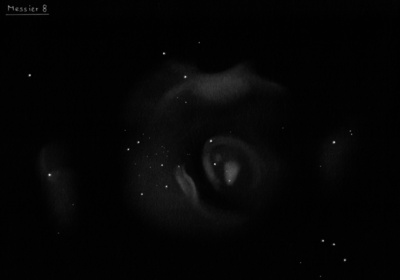
Giovanni Hodierna discovered NGC 6530, the associated cluster within M8 = Lac III-13 = h3722. He catalogued it as II. 6 in his 1654 "De Admirandis Coeli Caracteribus". John Flamsteed called it a "nebula" around 1680 but Guillaume Le Gentil was perhaps the first to recognize (telescopically) the mix of nebulosity and stars around 1747. Using a small 18- to 20-foot focal length refractor, he noted "a small nebulosity like the tail of a comet with numerous stars." His position was off, though, by more the one degree.
Earlier observers appear to have thought the naked-eye glow resolved into stars in a telescope. When Philippe de Cheseaux reviewed Flamsteed's observation in 1745-46 he concluded the object appeared as a "truly nebulous" star naked-eye but as a star cluster through a telescope. Nicolas-Louis de Lacaille catalogued M8 as a nebulous star (III. 13), based on his observation at the Cape in 1751-52, though with a 1/2-inch telescope he couldn't resolve the object. Messier's 1764 observation mentioned "a cluster of stars that appears to be a nebula when observed with a simple three-foot refractor; with an excellent instrument, however, one sees only a large number of faint stars. Near this cluster there is a fairly bright star [9 Sgr], which is surrounded by a very faint glow."
William Herschel observed M8 on 22 May 1784 (sweep 223) and logged "large, extended, pretty bright, broad. The nebulosity of the milky kind, there are some pB stars in it, but they seem to have no connection with it, being of very different sizes [magnitudes] and colours and resembling the other stars that are everywhere scattered about in this neighborhood. This is probably the star surrounded with nebulosity mentioned by Messier. There is indeed one of the stars which are in the nebula that is somewhat larger [brighter] than the rest and may be the only one he saw." John Herschel produced a beautiful drawing of the nebula with carefully positioned stars (Plate I, fig 1), though Wilhelm Tempel questioned it as differing significantly from his own.
Stephen O'Meara states, "The word "Lagoon" was probably first used in association with M8 by Agnes M. Clerke in her 1890 wor entitled The System of the Stars."
400/500mm - 17.5" (6/6/86): extremely bright, detailed nebulosity that nearly fills a 50' field. Extensive fainter nebulosity fills the region to the north and a thin extension is to the east. Cut by a large high contrast dark lane ("Lagoon") oriented SW-NE. The brightest luminary within the nebula is 9 Sagittarii (V = 6.0), situated to the west of the dark lane with a mag 7 companion 3' NNE. A very bright 30" nebulous knot ("Hourglass Nebula", ionized by O7 star Herschel 36) is situated 3' SW of 9 Sagittarii. NGC 6530, a bright open cluster, is on the east side of the dark lane. Barnard 89 is a fairly well-defined roundish dark nebula ~6' following NGC 6530. The Lagoon is a prominent naked-eye object in dark sky. See observing notes for NGC 6530 and IC 1271. The Trifid Nebula (M20) lies 85' NNW.
Notes by Steve Gottlieb
M 22
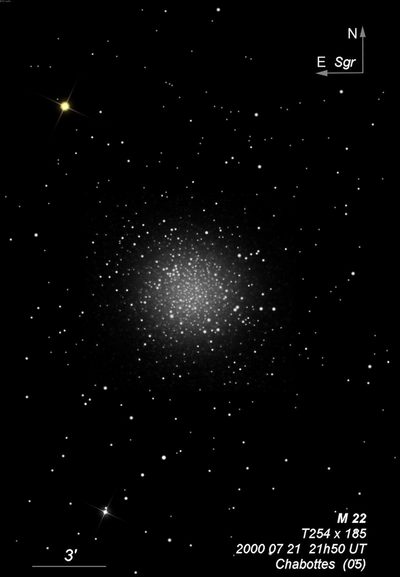
Naked eye: This is the third brightest globular in integrated magnitude (V = 5.2) and generally a difficult naked-eye object in a dark sky from northern California. It was a fairly easy naked-eye from Australia, though not as obvious as I expected.
Johann Abraham Ihle discovered M22 = NGC 6656 = Lac I-12 = h2015 = h3753 on 26 Aug 1665 during an observation of Saturn. This was the first globular cluster discovered. It was reported that Hevelius had seen it earlier, but he didn't include M22 in his list. Edmond Halley observed and included this globular in his 1715 list of six nebulae. Nicolas-Louis de Lacaille observed M22 on 6 Apr 1752 with a 1/2" telescope at 8x, during his expedition to the Cape of Good Hope. William Herschel noted it was "All resolved into stars" on 4 Jul 1783 using his 12-inch reflector (small 20-foot). On 12 Jul 1784 (sweep 236), he called it "a most beautiful extensive cluster of stars of various magnitudes, very compressed in the middle. R and about 8' dia besides the scattered ones which do more than fill the extent of the field, L, r."
From the Cape of Good Hope, John Herschel recorded (sweep 793), "globular cluster; vB; vL; vm comp; vgvmbM; 7' diam. The stars are of two magnitudes, viz., 15..16m and 12m; and what is remarkable, the largest of these latter are visibly reddish; one in particular, the largest of all (= 11-12m) sf the middle, is decidedly a ruddy *, and so I think are all the other large ones."
200/250mm - 8" very bright, very large, extremely rich. A few hundred mag 11-13 stars were resolved and the globular appeared highly resolved down to the core. A bright clump as visible in the NE section of the core. The cluster contained a wide variation of magnitudes. M22 is the second best globular for viewing from Northern California (next to M13), although it has brighter members).
400/500mm - 17.5" (8/4/94): at 220x appears 10' diameter although outliers may significantly increase the total diameter. The very bright core appeared irregularly round and 3.5'-4' diameter but not concentrated to the center. M22 was extensively resolved to the center and there was no distinct nucleus. At the NE edge of the core I noticed a rich small clump with 8-10 stars that collectively stood out well and an easy bright pair at the SE edge of the core. The very irregular halo appeared more extensive on the NE side and seemed elongated SW-NE. Dark lanes appeared to intrude into the cluster and involve the surrounding region, though this may be an optical effect.
600/800mm - 24" (7/21/12): M22 displayed a few distinct orange/red supergiants. Two colored stars are on the southwest and southeast side of the core. A third fainter star forming an isosceles triangle to the north (closer into the core) is also orange/red.
Naked-eye - (8/19/09 and 8/3/11): fairly easy naked-eye fuzzy (non-stellar) glow from Northern California. Bracketed by two mag 5.5-6 stars about 35' NE and a similar distance west.
Notes by Steve Gottlieb
M 17
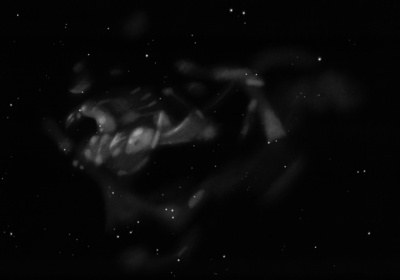
Philippe Loys De Chéseaux discovered M17 = NGC 6618 = h2208 in 1745-46 from Paris and wrote, "It has perfectly the form of a ray, or of the tail of a comet, of 7' length and 2' broad; its sides are exactly parallel and rather well terminated, as are its two ends. Its middle is whiter than the borders. Charles Messier rediscovered M17 on 3 Jun 1764 and described "a train of light without stars, 5' or 6' in extent, in the shape of a spindle, a little like that in Andromeda's belt, but the light is very faint..."
William Herschel, using his small 20-ft (12-inch aperture) telescope on 2 Aug 1783, called M17 "a curious train of light. I cannot resolve it." On 27 Jun 1786 (sweep 576) he logged "an extensive milky nebulosity of more than 20' in length, with a hook to the preceding side, bended towards the south; the extent is from np to sf and looses itself imperceptibly. The hook includes a dark place, almost resembling that in the nebula of Orion."
On 6 Aug 1823 (sweep 48), John Herschel recorded "A large extended nebula. Its form is that of a Greek Omega with the left (or following) base-line turned upwards. The curved (or horse-shoe) part is very F, and has many stars in it. The preceding base-line hardly visible. The following, which is the principle branch, occupies nearly half the field (7 1/2'). Its light is not equable, but blotty. Strong twilight." He didn't describe the nebula from the Cape of Good Hope, but his published sketch (plate II, figure 1) shows from 1837 shows a second curve at the east end, hooking north. Based on the sketch, Dreyer referred to M17 as "2-hooked" in the NGC, an odd description.
200/250mm - 8" (7/16/82): very bright, large, very detailed. The brightest portion consists of a long bright ray that hooks south at the west end. A fainter section oriented N-S section follows. The main bar is mottled. The irregular hooked portion is clearly mixed with a dark nebula intruding. Fainter nebulosity is visible north and south of the main bar.
300/350mm - 13.1" (7/16/82): the "Swan Nebula" is very bright, very large, with fantastic detail along the bright bar. Has a turbulent texture with dark areas near the "hook". A nebulous halo surrounds the brighter star to the south.
Notes by Steve Gottlieb
M 20
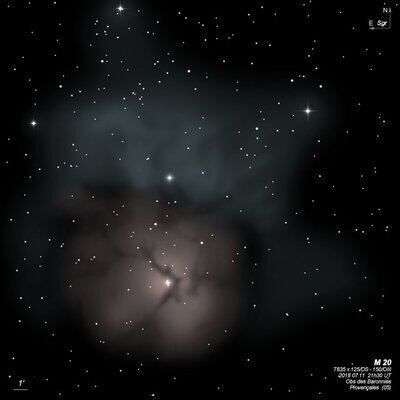
15x50 IS binoculars: visible as a small, faint glow surrounding a the central "star".
Charles Messier discovered M20 = NGC 6514 = H IV-41 = H V-10/11/12 = h1991 = h3718 on 5 June 1764 and noted a cluster of stars. William Herschel first observed M20 on 12 Jul 1784 (sweep 236) and recorded, "Three nebulae, but they seem to join faintly together, forming a kind of triangle; in the middle of which is less nebulous, or perhaps free from nebulosity is a double star of the 2nd or 3rd class. As I intended to revisit this place very soon I passed on, but think more very faint nebulosities are following." He assigned it three catalogue numbers, V 10, V 11 and V 12. His reference star was misidentified, though (4 Sgr = SAO 186061 instead of 5 Sgr = SAO 186074), so his position is incorrect. William Herschel also reobserved the Trifid on 26 May 1786 (sweep 566) and recorded IV-41 using a different reference star as "a double star with extensive nebulosity, of different intensity; about the double star is a black opening, resembling the nebula in Orion, on a small scale." John Herschel combined these numbers into a single GC entry (4355). Harold Corwin notes he made the same error with NGC 6533.
John Herschel first used the name "Trifid" to describe M20 in the Slough Catalogue (1 Jul 1826): "vL; trifid, three nebulae with a vacuity in the midst, in which is centrally situated the double star Sh 379, neb = 7' in extent. A most remarkable object." Interestingly neither William or John referred to this object as M20, possibly because of positional confusion or because Messier called it a "star cluster". The equivalence was given in the GC 4355.
In John Herschel's Cape Observations (1847) and "Outlines of Astronomy" (1849) he described "One of the them [several nebulae in Sagittarius] is singularly trifid, consisting of three bright and irregularly formed nebulous masses, graduating away insensibly externally, but coming up to a great intensity of light at their interior edges, where they enclose and surround a sort of three-forked rift, or vacant area, abruptly and uncouthly crooked, and quite void of nebulous light. A bright triple star is situated precisely on the edge of one of these nebulous masses just where the interior vacancy forks out two channels. A fourth nebulous mass spreads like a fan or downy plume from a star at a little distance from the triple nebula."
200/250mm - 8" (7/16/82): the famous rift structure is fairly prominent with a triple star at the center. The NW rift is more subdued. An easily visible reflection nebula is close north.
300/350mm - 13.1" (7/16/82): bright, fairly large, contains three inky black dark lanes (B85) with sharp edges. Structure is visible along the dark lanes and in the center. The prominent central star is a quadruple (4th star difficult) consisting of a mag 7.6/10.4 pair at 6" and a mag 8.7/10.5 pair at 2.3", the brighter stars separated by 11". The NW lane is wider and fainter than the other two lanes. A round, bluish reflection nebula is separated, but very close north. The view improves using a UHC filter.
400/500mm - 18" (8/12/10): the emission component of M20 was sketched and observed carefully at 175x. At the intersection of the dark lanes is the multiple central star HN 40 with a mag 7.6/10.4 pair at 6" and a tight mag 8.7/10.5 pair at 2.3", with the two pairs are separated by 11". Four lanes (B85) emanate from the bright central hub. A narrow lane starts NW of the multiple star and heads 2.5' due N, where it stops at a mag 10 star. Near the base of this lane another branch heads west to the edge of the nebula. Another lane heads SSE for ~2.5', tapering at the end. A prominent lane shoots 3.5' NE and has a few short branches, including one just NE of the central stars. This lane is bordered by a couple of mag 10.5-11 stars on its south edge. There is an extension at the NE end that bends to the north and exits the main nebulosity and merging with a dusty region just SE the reflection component to the north. A mag 9.4 star is at the north edge of the main emission component. The blue reflection component surrounds mag 7.3 HD 164514 and extends ~6' with an irregular structure.
Notes by Steve Gottlieb
M 24
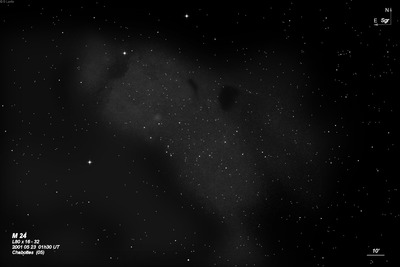
Charles Messier "discovered" M24 = "Small Sagittarius Star Cloud" = IC 4715 telescopically on 20 Jun 1764, although it is of course a prominent naked-eye object. E.E. Barnard photographed the region in 1905 and described in AN 4239 ("Some notes on nebulae and nebulosities"), "The magnificent star cloud...is remarkable for the definiteness and angularity of its south and following outlines. The east side is about 42' long and is very straight. The south side is somewhat irregular and much longer. The run south preceding for about 90' and then joins the great bed of nebulous matter just described. The northern edge of this star cloud is diffused. In the cloud towards its northern edge, are two remarkable black holes..." His position, though, was 10 min of RA too large, so Dreyer didn't recognize it as M24. Brent Archinal caught the error and made the equivalence (see Corwin's identification notes). William Herschel apparently first observed M24 on 2 Aug 1783 with his 12-inch and noted "considerable stars in great number." John Herschel lists his cluster h2004 = NGC 6603 as M24, so he didn't realize the Messier entry applied to the entire star cloud, not the small embedded cluster.
200/250mm - 8" (7/3/80): IC 4715 refers to the remarkable Small Sagittarius Star Cloud (prominent naked eye object). Best view at very low power as it extends beyond the edges of the field. The rich open cluster NGC 6603 is embedded in the NE side.
Notes by Steve Gottlieb
M 25
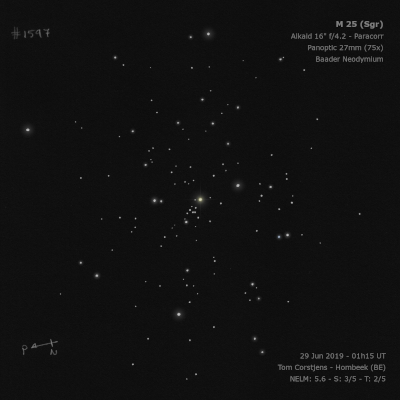
Philippe de Chéseaux discovered M25 = IC 4725 in 1745-46 but it was not included in the GC or NGC despite being independently discovered by Messier in 1764, observed by William and Caroline Herschel in July 1783 ("Very large stars and some small ones; I counted 70, and there are many more within no considerable extent"), Admiral Smyth in 1836 and Reverend Thomas Webb in 1859. Solon Bailey found the cluster on a photographic plate in 1896 using a 1" Cooke lens at the Arequipa station. The discovery was reported in "A Catalogue of Bright Clusters and Nebulae" (Annals of Harvard College Observatory, Vol LX, No. VIII, 1908). Dreyer equated IC 4725 with M25, but though credited Bailey with the position.
400/500mm - 17.5" (8/27/92): about 100 stars in 30' field although fills 45' field at 82x. The densest portion in the center is a group of 7 fairly bright stars situated between two bright stars mag 6.5 (U Sgr) and 8.0 oriented E-W. U Sagittarii (6.3-7.0) is located at the east end and is the brightest star in the cluster. Just south of this group is a long dark lane void of stars oriented E-W that appears darker than the background. Bordering the south edge of this dark lane is an elongated group of 10 stars including Bu 966, a nice evenly matched double star at 11" separation. To the west of this string are two mag 9 and 10 stars oriented SW-NE. The cluster includes several colored stars and is visible naked-eye just south of a mag 5 star.
Naked-eye - (8/31/11): very easy to see as a naked-eye "patch" (total V = 4.6) in a dark sky.
Notes by Steve Gottlieb
M 23
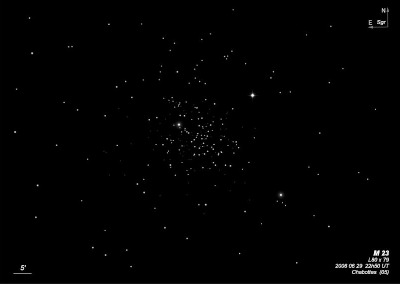
Charles Messier discovered M23 = NGC 6494 = h1990 on 20 June 1764. On 18 Jun 1784 (sweep 230), WH recorded "a cluster of beautifully scattered large stars, nearly of equal magnitudes; (visible in my finder) it extends much farther from the field of the telescope will take in, and in the finder seems to be a nebula of a lengthened form extending to about half a degree." JH made 3 observations, logging on sweep 269 ( 15 July 1830) "A star 10m in the centre of a beautiful discrete cluster of 60 or 70 stars 10 and 11m and one of 9-10. They run in lines and arches. It is loose and straggling, and the sky around it has a dotted appearance."
200/250mm - 8" (6/29/84): bright, fairly large with long star lanes to the edge of the field.
300/350mm - 13.1" (6/29/84): bright, large, rich, appears fully resolved. Very pretty open cluster.
400/500mm - 18" (8/12/10): stunning bright, rich cluster at 175x with several hundred stars visible in the 35' field with a large number of mag 9-11 stars sprinkled throughout the cluster. Many of the stars are arranged in long chains and loops with a distinctive chain of 5 stars curving NNW to SSE near the center and a longer curve of stars to the southwest. A string of stars heads NW out of the cluster to mag 6.5 HD 163245 outside the field. The stars are fairly evenly distributed with the density gradually thinning towards the edges. Two catalogued double stars are ARA 718 (10.9/12.3 at 5") near the center and ARA 719 (9.8/13.0 at 15") on the SE side. The Milky Way has a bright background glow just west of the cluster.
Notes by Steve Gottlieb
M 21
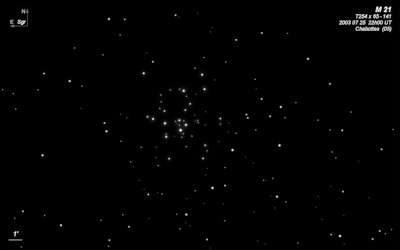
Charles Messier discovered M21 = NGC 6531 = h1993 on 5 Jun 1764. On 26 May 1786 (sweep 556), WH noted "a rich cluster of large stars." On 28 Jul 1830, JH recorded "A tolerably rich, sc, coarse cl; one star 9m, the rest 10....12." His single position was 6' too far east.
400/500mm - 17.5" (8/10/91): M21 consists of roughly 50 stars in a 5' diameter. Very bright, fairly small although outliers greatly increase the diameter. Includes a wide double star south 698 = 7.9/8.8 at 30". Just north of these stars is a remarkably symmetric ring consisting of a mag 9.5 star and ten mag 12-13 stars. A close mag 14/14 double star is on the west side of the bright double star. Just west is a 10' string of mag 8/9 stars oriented NW-SE including two double stars. M20 lies 45' SW. Easily visible in 15x50 IS binoculars as a small knot.
Notes by Steve Gottlieb
M 55
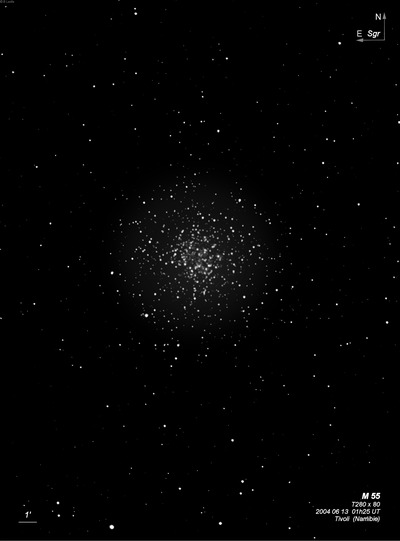
Nicolas-Louis de Lacaille discovered M55 = NGC 6809 = Lac I-14 = D 620 = h3798 in 1751-1752 during his expedition to the Cape of Good Hope. He used only a 1/2-inch refractor at 8x and described it as appearing "like the obscured nucleus of a big comet." Messier couldn't find it in 1764 but succeeded in 1778, describing it as "a nebula which is a whitish spot; extending for 6' around the light is even and does not appear to contain a star."
William Herschel mentions in Philosophical Transactions for 1818: "30 Jul 1783, small 20 feet telescope (12-inch). With 250 power fairly resolved into stars; I can count a great many of them, while others are too close to be distinguished separately. 1784, 1785, 20 feet telescope (18.7-inch). A rich cluster of very compressed stars, irregularly round, about 8' long."
James Dunlop described the cluster as "a beautiful, large round bright nebula, about 6' or 7' diameter, gradually condensed to the centre, easily resolvable." His position is 24' too far east. On 3 Aug 1834 (sweep 478), John Herschel recorded "Globular cluster; pB; vL; R; vglbM; diam in RA 30.0s; all resolved into separate st 13...16 m; not so comp M as to run together into a blaze or nipple. "
200/250mm - 8" (9/3/83): at 100x; faint stars resolved across entire disc, no compact core, over unresolved haze. Highly resolved at 165x.
300/350mm - 13.1" (9/3/83): bright, large, superb resolution of at least 75 stars mag 12 and fainter. Loosely compressed with a broadly brighter core, irregular background glow. One of the easiest resolved globulars.
400/500mm - 17.5" (7/14/99): at 100x this a beautiful, highly resolved cluster with outliers extending out to at least 12' in diameter. At 220x, there is uniform covering of easily resolved stars across the halo and the broadly concentrated core. In addition the central region is contains a layer of very faint stars over unresolved haze. The star density drops off rapidly in the outer halo and becomes very scraggly around the periphery. The core also seems indented on the SE side with a void in the halo on this edge.
600/800mm - 24" (9/2/16): at 200x; superb, very highly resolved showpiece globular of several hundred stars, spreading out at least 15' in diameter. Contains a very large, very bright core that is uniformly covered with similar, relatively bright resolved stars. The core has a loose appearance and doesn't increase to a nuclear peak. The central portion has a distinct 3-dimensional appearance with the brighter stars overlaying a second dense carpet of fainter stars against an unresolved background glow. The halo is very large and well resolved with a mix of brighter and fainter stars. The periphery of the halo is irregular or scraggly, but roughly symmetrical.
Notes by Steve Gottlieb
M 28
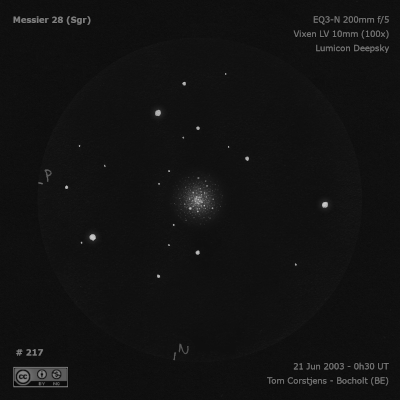
Charles Messier discovered M28 = NGC 6626 = h2010 = h3743 on 27 July 1764. WH first observed this globular on 4 Jul 1783 with his 12-inch (small 20-foot) and noted "if the night were clearer I double not of its being stars that might be seen very distinctly." On 12 Jul 1784 (sweep 236) he logged "A cl of exceedingly compressed stars, vBM, R, with 3 or 4 small, irregular branches. The large stars red."
JH recorded (sweep 474 from the CGH) "globular; vB; R; vm comp; gbM, but not to a nipple; diam in RA = 12 seconds; resolved into st 14...16m; a fine object. Occurs in the milky way, of which the stars here are barely visible and immensely numerous."
200/250mm - 8" (7/16/82): bright, sharp concentration, lively halo just resolves into many faint stars at 200x!
300/350mm - 13.1" (6/29/84): a prominent star chain extends to the north.
13.1" (7/16/82): very bright, fairly large, sharp concentration with a lively unresolved core. A few stars are resolved at the edges of the core over haze and many stragglers resolved including long spidery chains. A total of a few dozen stars resolved. Excellent view at 290x and a star chain to the north is prominent.
400/500mm - 17.5" (7/10/99): striking globular at 220x, with the halo appearing ~4.5' in diameter and a very bright core ~2'x1.5' elongated SSW-NNE. Extensive resolution at 280x and 380x with roughly 50 stars resolved in the halo. At 380x the edges of the core really start breaking up into numerous stars and a rich sprinkling of stars is superimposed on the well-defined core. On the north side of the halo a long star chain heads directly north and a fainter but richer chain starts to trail off the east side of the core but abruptly turns in a chain heading NNW.
Notes by Steve Gottlieb
M 18
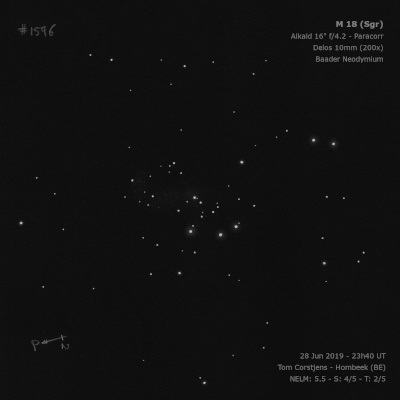
Charles Messier discovered M18 = NGC 6613 = h2007 on 3 Jun 1764 and recorded "A cluster of small stars, a little below above nebula, No. 17, surrounded by slight nebulosity, this cluster is less obvious than the preceding, No. 16: with an ordinary telescope of 3.5-foot [FL], this cluster appears like a nebula; but with a good telescope one sees nothing but stars. (diam. 5'). On 22 Jun 1784 (sweep 231), WH logged it as "a cl of coarsely scattered L stars, not rich." On 16 Jul 1830, JH called it "A poor and coarse cluster. Contains about a dozen stars 10m and 15 or 20 more 12 .. 15m."
400/500mm - 17.5" (8/1/92): at 100x, bright, scattered, includes three mag 9 stars and 10 mag 11 stars. The bright stars form a "V" asterism with the vertex to the NNE. Includes a few wide double stars. At 220x, 40 stars are visible in a 7' diameter, scattered but distinctive. The bright group of 15 stars forming the "V" asterism is surrounded by a dark circular void. The rest of the cluster is to the south and west of the "V". Only a few faint stars are involved and the cluster appears fully resolved.
Notes by Steve Gottlieb
M 54
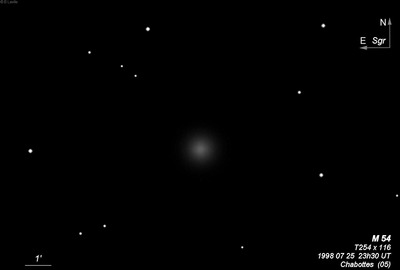
15x50mm IS binoculars (8/3/11): easily visible as a small fairly faint glow.
Charles Messier discovered M54 = D 624 = h3763 on 24 July 1778 and described a "very faint nebula, discovered in Sagittarius. It is bright in the centre and contains no star, seen with an achromatic telescope of 3.5 feet". On 24 Jun 1784 (sweep 232), William Herschel recorded "A round, resolvable nebula. Very bright in the middle and the brightness diminishing gradually, about 2.5' or 3' diameter. 240 power shews two pL stars in the faint part of the nebulosity, but I rather suppose them to have no connection with the nebula. I believe it to be no other than a miniature cl of v compressed stars resembling that near the 42nd Comae [M53]. It is like that under Delta Sagittarii [NGC 6624], but rather larger and brighter though not much."
James Dunlop found it "a very beautiful nebula, with a very bright round well-defined disk or nuclei, about 15 arcseconds diameter, surrounded by a gradually decreasing light or chevelure, about 1 1/4' diameter, this is exceedingly bright immediately at the centre." He made 4 observations of the globular and his published position is 28' east of center (not an unusually large error). John Herschel made several observations and noted on 1 Aug 1834 from the Cape of Good Hope, "Globular cluster; B; pL; vlE; gbM; 2 1/2' diam; resolved into st 15m, with a few outliers 14m."
M54 is the most distant Messier globular, roughly 85,000 light years away and lies close to the center of the Sgr Dwarf Spheroidal (SagDEG or Sgr dSph). M54 is thought to be the core of the disrupted galaxy but it has been proposed that it formed independently and plunged into the nucleus of the Dwarf as a result of the decay of its orbit due to dynamical friction.
400/500mm - 17.5" (8/2/86): very bright, fairly large, increases to a sharp bright core. Five brighter stars were easily visible around the edges, though these are probably field stars as the brightest cluster members are V = 15.5. The globular had a mottled, grainy appearance but there was no additional obvious resolution into stars. Easily visible in the 16x80 finder.
Notes by Steve Gottlieb
M 70
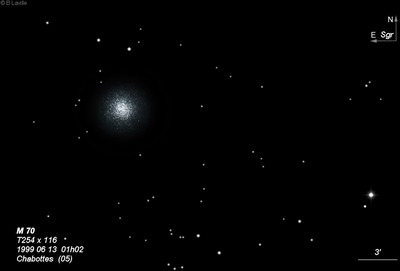
15x50mm IS binoculars (8/3/11): very small, fairly faint glow, brighter center, not difficult.
Charles Messier discovered M70 = NGC 6681 = D 614 = h3756 on 31 Aug 1780 and described "a nebula without star, near the preceding [M 69] and on the same parallel. Near to it is a 9 mag. star and four small telescopic stars, almost in the same straight line, close to one another and situated below the nebula as seen in a reversing telescope. Diam. 2'." On 13 Jul 1784 (sweep 237), William Herschel recorded "easily resolvable, cB, pL, iR. A very faint red perceivable." James Dunlop recorded it on 2 Jun 1826 as "a pretty bright round nebula, about 1 1/2' diameter, very much condensed to the centre." Dunlop claims 5 observations in his catalogue. On 1 Aug 1834 John Herschel recorded "globular, B, R, gmbM, diam in RA = 7 seconds; resolved into stars 14...17m."
200/250mm - 8" few faint stars resolved at high power, bright core. The halo appears flattened on the east side.
300/350mm - 13" very small bright core, faint stars are resolved at the edges. A bright string of stars at the following side trails to the NNE.
400/500mm - 17.5" (7/14/99): At 220x, M70 displays a 3' round halo and is very well concentrated to a small bright core and intense nucleus. A string of three brighter stars extends to the north from the northeast end and a number of stars are resolved in the halo. At 280x, ~15-20 faint stars are resolved in the halo and at the edge of the core, particularly on the south side over a very lively background.
Notes by Steve Gottlieb
M 69
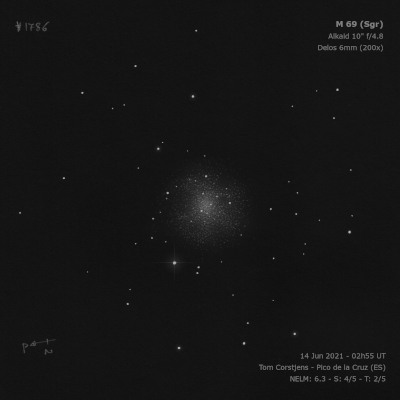
15x50mm IS binoculars (8/3/11): small, fairly faint glow. The mag 7.9 star 4.5' NW was cleanly resolved from the globular.
Charles Messier discovered M69 = NGC 6637 = D 613 = h3747 on 31 Aug 1780 and described "a nebula without star in Sagittarius... Near to it is a 9 mag star; the light is very faint; can be seen only in a good sky, and the least illumination of the micrometer wires extinguishes it... This nebula has been observed by M. de Lacaille and reported in his catalogue. It resembles the nucleus of a little comet. Diam. 2'." Glen Cozens states that Messier mistakenly assumed Lac I-11 referred to M69 and Lacaille's object is more likely just an asterism. See NGC 6634 or more.
William Herschel observed M69 in 1784 and noted "Very bright, pretty large, easily resolvable, or rather an already resolved cluster of minute stars. It is a miniature of the 53d of the Connoissance [M53]." James Dunlop observed it 4 times and described "a pretty bright round well-defined nebula, about 1 1/4' diameter, gradually condensed to the centre; there is a small star about 1' south of the nebula." John Herschel made 3 observations from the Cape of Good Hope. On 1 Aug 1834, he logged "globular, B, R, vgbM, resolved into stars 14..15m, diam 10 seconds in RA." Two nights later he noted "globular, pB, R, 3' diam, stars 14..15m." Christian Peters reported finding it around 1850 in Naples (AJ 2, 1856) and claimed it do not appear in any of his books.
200/250mm - 8" fairly bright, bright core, lively halo, few stars at edges, difficult to achieve resolution.
400/500mm - 17.5" (7/29/92): M69 is bright, moderately large, 3' diameter, round, fairly symmetric appearance with a large core surrounded by a small halo. A bright mag 12.5 star is embedded in the core or it contains a bright stellar nucleus. Several easy mag 13.3-14.0 stars were resolved around the edges of the halo and 15-20 very faint mag 14-15 stars were resolved in the halo with averted vision. Additionally, a few stars are also detected over the core. This is a very pretty globular with averted vision. Located 4.5' SE of mag 7.9 SAO 21059.
Notes by Steve Gottlieb
M 75
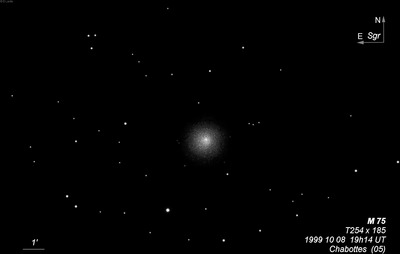
15x50 IS binoculars (9/26/11): easily picked up as a very small, round glow with a bright, nearly stellar center and a small fainter halo.
Pierre Méchain discovered M75 = NGC 6864 = h2064 on 27 Aug 1780 and confirmed by Messier in Oct. WH found "some of the stars are visible." On 3 Sep 1831 (sweep 369), JH recorded "vB; R; vsvmbM; 2'; a bright R ball 15" diam, in an atmosphere 2'; 320 does not show the stars but makes it more resolvable."
300/350mm - 13.1" (8/25/82): bright intense core surrounded by a fainter halo that is slightly mottled but with no obvious resolution.
400/500mm - 17.5" (7/14/93): bright, moderately large, 3' diameter, round, very bright striking core 30" diameter, very mottled. Several extremely faint 15th mag stars pop in and out of view with averted vision in the outer halo. A mag 14 star is in the inner region just NE of core. The cluster almost reaches four mag 12.5-13 stars, which cradle the globular on the south and NE sides, and a fainter star is off the NW side. This cluster is quite concentrated and is the only Shapley-Sawyer class I globular in the Messier catalogue.
Notes by Steve Gottlieb
NGC 6822
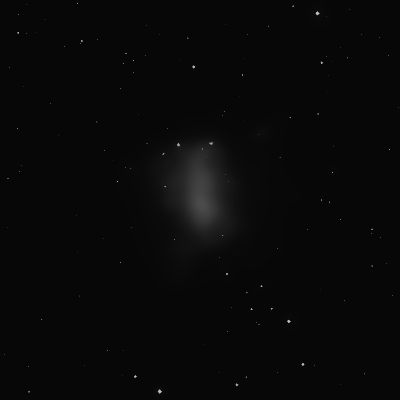
200/250mm - 8" (8/28/81): very faint, elongated N-S, similar to a faint Milky Way patch.
400/500mm - 17.5" (7/14/99): the exact position of the HII ring Hubble III on the NW side of the galaxy was examined carefully at 280x without a filter and on several occasions an extremely faint, round, 15" glow popped into view with averted vision ~1.5' W of a mag 13.5-14 star. A mag 15.5 star is visible a similar distance SSE of the reference star. This HII knot was clearly nonstellar, although it didn't have the annular ring appearance seen on images. Viewed on an evening of exceptional transparency at the Sierra Buttes.
17.5" (5/10/91): at 82x, this Local Group Member appeared fairly faint, very large, low but uneven surface brightness, elongated 5:2 N-S, 14'x6'. Diffuse appearance and the boundary is difficult to define, requires low power. Several faint stars are superimposed with a couple of brighter stars on the north side. Using an OIII filter two small, faint HII knots (Hubble X = IC 1308 and Hubble V) stand out well on the north and NW edges. Both of these knots are 2' NW of mag 12 stars. Planetary nebula NGC 6818 lies 40' NNW.
17.5" (7/16/88): easily visible as a large, elongated, low surface brightness glow.
900/1200mm - 48" (5/16/12): the four HII regions on the north side of the galaxy were carefully observed. IC 1308 = Hubble X appeared bright, fairly small, irregularly round. At ~30" diameter this HII knot is slightly larger than Hubble V and more uniform in surface brightness. Hubble V is bright, fairly small, irregularly round. This irregular HII region spans 20"-25" and has a higher surface brightness than IC 1308 3' E. A bright knot is on the SE end. Hubble III was immediately visible as a faint to fairly faint glow, fairly large (largest of the four regions), round, ~0.9' diameter. Occasionally, when the seeing steadied the ring structure popped and a brighter rim and darker center was visible. Smaller and slightly fainter Hubble I is virtually in contact at the NW edge and sometimes the two glows merged into a single large, irregular glow. Hubble I is the faintest and westernmost of the main HII regions and appeared as a faint, moderately large, round glow of ~36" diameter, barely off the NW side of larger Hubble III.
Notes by Steve Gottlieb
NGC 6818
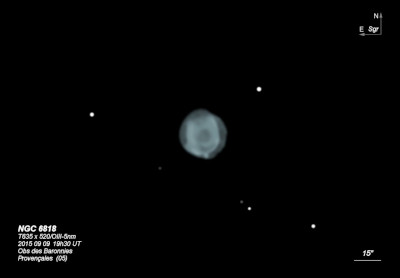
William Herschel discovered NGC 6818 = H IV-51 = h2047 on 8 Aug 1787 (sweep 749) and recorded "a small beautiful planetary nebula, but considerably hazy upon the edges; it is of uniform light throughout, considerably bright. Perfectly round, 10 or 15" in diameter. My brother Jacob being in the gallery, I showed it to him." His position was very accurate.
John Herschel reported that "It is exactly like a planet and two satellites. Distance of A, the nearer, 20", Pos 45° np; of B, 25", 20° nf." JH was interested in the idea that in some cases PN were accompanied by satellites (NGC 6905 and NGC 7662 are two other examples he mentioned). Other astronomers, such as Olbers, were also interested in this notion.
On 28 Aug 1850, Lord Rosse (or his assistant) recorded, "vB, blue planetary neb, edges not sharp, a little darker in the middle." A year later, assistant Bindon Stoney logged "the dark part is a little np middle." In 1856 Father Secchi noted (and sketched) a darker center in the shape of a cross using a 9.5" refractor at 1000x.
Based on Crossley photographs at Lick, Curtis (1918) wrote "A rather irregular oval ring 22"x15" in p.a. 10°, fainter along and at the ends of the major axis. A fainter narrow ring shows at east and west outside of the inner bright ring."
John Mallas coined the nickname "Little Gem" in the Jun/Jul 1963 article "Visual Atlas of Planetary Nebulae-V", published in the "Review of Popular Astronomy". He noted it was "the bluest of the planetaries I have observed."
300/350mm - 13.1" (9/3/83): very bright, slightly elongated N-S, fairly small.
400/500mm - 17.5" (7/12/99): at 100x this striking PN is bright and small with an obvious blue color. The high surface brightness easily allows high power. At 380x, there is subtle but obvious structure with a darker center and an irregular brightness to the halo. Most noticeably the PN is brighter on the east end and mildly annular. Appears slightly elongated N-S, ~20"x15" in size. Three mag 13-13.5 stars are nearby at 40" NW, 1.0' E and 1.3' SW.
17.5" (7/16/88): at 412x appears very bright, fairly small, slightly elongated N-S, blue color, very high surface brightness. Appears brighter along the east side and slightly brighter along the west side compared to the center. Has a darker elongated center but the annularity has a pretty low contrast. Barnard's galaxy NGC 6822 lies 40' SSE.
600/800mm - 24" (8/25/19): viewed at 375x, 500x, 644x, and 1000x; easily takes high power due to its high surface brightness and good seeing. The annular structure, though only moderate contrast, was very interesting with a relatively large, oval darker center and a very irregular, relatively narrow ring with an irregular surface brightness (brighter spots). The edge was soft in sections with a strong impression of a thin faint halo.
24" (7/19/17): at 375x, 500x, 750x and 1000x: small, very high surface brightness oval, slightly elongated N-S, with a blue color at 375x, takes up to 1000x! The planetary is encased in a thin outer shell. Occasionally the center seemed to sharpen to a point, but I couldn't confirm the central star with confidence. The rim seemed to sparkle with slightly brighter regions. Located 40' N of Barnard's Galaxy (NGC 6822).
Notes by Steve Gottlieb
NGC 6445
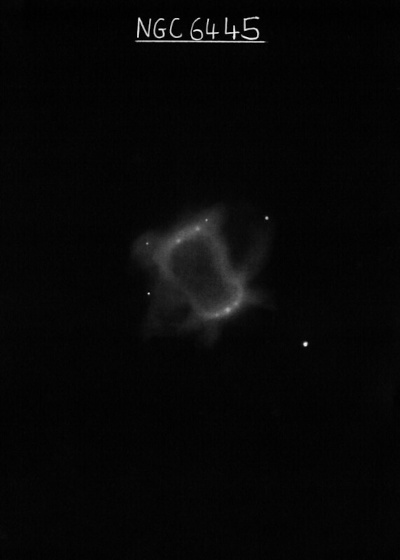
William Herschel discovered NGC 6445 = H II-586 = h1986 on 28 May 1786 (sweep 569) and recorded "pB, S, iF." He placed it in his class II of "Faint Nebulae". John Herschel called this planetary "pB; pL; R; r; 40"." On 11 Mar 1848, LdR (or assistant William Rambaut) described NGC 6445 as "curious circular-shaped neb with large dark spot at one side [f side in a diagram], around which is a close cluster of well defined vS stars." Edward Pickering apparently found NGC 6445 while searching with a direct-vision spectroscope at Harvard College Observatory (Sidereal Messenger, Oct 1882). In 1887, Frank Muller reported with the 26-inch refractor at the Leander McCormick Observatory, "Two nuclei forming an elliptical nebula, elongated 150°, largest diameter 26", northern nucleus brighter. A sketch shows each nucleus to be elongated in the direction 90° +/-, the center being almost devoid of nebulosity. The nuclei are entirely separated from each other except by very faint nebulosity, and are of the 12.5 magnitude."
Based on Crossley photographs, Curtis (1918) reported "..the brighter portioin is a very irregular "square-shouldered ring 38"x29"; from this extend very faint ring like ansae in p.a. 50-230°, along which the total length is about 50". Brightest on NW edge..." Based on Helwan photographs in 1919-20, it was reported as "trapezium-shaped object with very sharp corners; the two parallel sides are considerably brighter than the other pair and lie in p.a. 60° and 240°; the NE corner is a right angle; no indication of a central star."
The Sky Catalogue 2000, Volume 2 and the Deep Sky Name Index 2000 incorrectly refer to NGC 6445 as the "Little Gem". The nickname applies to NGC 6818 (from John Mallas). John Mallas coined the nickname "The Crescent" in his Apr/May 1993 article "Visual Atlas of Planetary Nebulae-IV", but the nickname didn't stick.
200/250mm - 8" (6/27/81): fairly bright, elongated, uniform. Located within string of four mag 11/12 stars.
300/350mm - 13.1" (7/16/82): dark center at 280x appears to bisect the planetary ~E-W.
400/500mm - 17.5" (7/14/99): this bright PN is striking at 280x with a great deal of structure evident. It has a boxy appearance, elongated NW-SE with dimensions ~45"x30". The ends of the major axis are clearly brighter with a bright, shallow arc or crescent-shaped curve on the NW end. This lobe has an irregular surface brightness with a couple of brighter spots. The SE lobe is brighter but has an oddly flat edge. At 380x, the eastern end of the southeast lobe is brighter and has a small extension or nodule that bulges out beyond the rectangular outline to the east. The center is clearly darker and with careful viewing appears as a dark band running SW-NE. A mag 12 star lies ~45" NW of center and the planetary precedes a wide uneven mag 8/10.5 pair by 5'. The planetary forms an unusual pair with GC NGC 6440 20' SSW.
600/800mm - 24" (8/14/15): this highly structured planetary was observed using 500x. NGC 6445 has an unusual rectangular shape, elongated 3:2 NW-SE, with dimensions ~45"x30". The planetary is brighter in fairly narrow strips along the four sides, creating an annular appearance. The short northwest facing side is slightly brighter and contains a bright knot or section near the middle. In addition, a faint knot is at the north vertex. Another bright knot is at the east vertex and either a faint knot or very faint star is at the south vertex. The short southeast facing side is sharply defined and quite straight. A very low surface brightness glow can be seen outside (east) of the eastern vertex. In addition, with careful viewing an extremely faint outer shell or loop is outside the long southwest facing side, connected at the two vertices along this side. A mag ~15.5 star is just outside the midpoint of the loop. The outer shell or loop on the northeast side was not seen.
Notes by Steve Gottlieb
NGC 6723
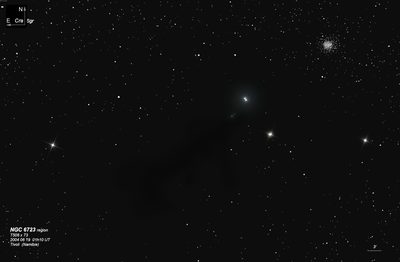
10x30mm (8/8/04 - Haleakala Crater): fairly bright in binoculars, situated just north of the top of the looping curve forming Corona Australis.
James Dunlop discovered NGC 6723 = D 573 = h3770 on 2 Jun 1826 and described "a beautiful bright round nebula, about 3.5' diameter, moderately and gradually condensed to the centre. This is resolvable. The moderate condensation, and the bluish colour of the stars which compose it, give it a very soft and pleasant appearance. This is rather difficult to resolve, although the condensation is not very great." Dunlop made 6 observations and his position is 16' too far east.
John Herschel credited Dunlop with the discovery despite the poor position and recorded on 31 Aug 1834 a "globular cluster; B; L; R or vlE; vgbM; diam 5'; perfectly resolved into stars 14..16m, with stragglers extending to 8' diam." Christian Peters independently found the globular around 1849 at the Capodimonte Observatory in Naples and it was reported as new in AJ 2, 1856. Apparently Peters didn't have access to JH's Cape Catalogue.
200/250mm - 8" (7/31/81): bright, large, bright core, mottled, some resolution of extremely faint stars around edges.
300/350mm - 13.1" (8/24/84): at 220x many faint stars resolved beyond the main disc.
13.1" (5/26/84): bright, large, mottled, many faint stars resolved across disc and at edges of halo.
13.1" (8/15/82): a number of very faint stars resolved around the periphery at 140x.
400/500mm - 17.5" (6/30/00): this is a beautiful, symmetric GC at 220x. The halo extends to ~6' and is sharply concentrated with a very bright 3' core. This core is highly resolved into a dense overlay of faint stars with a single brighter star just north of center. The extent of the halo is ill-defined and consists of numerous brighter stragglers (or field stars) mixed with a sprinkling of dim stars. Perhaps 70 stars are resolved in total. In a remarkable region with a complex of unusual reflection nebulae (NGC 6726/27/29).
17.5" (7/29/92): at 220x, bright, fairly large with about 50 stars visible in a 4'-5' diameter. Fairly symmetric appearance with no distinct edge. Beautifully resolved into several dozen stars. A mag 10.5 star is off the NE edge 3' from the core. Mildly concentrated but no distinct nucleus although a star appears embedded at the center of the core. The outer halo was well-resolved and a peppering of stars was resolved over the core. In the same low power field with bright nebula(NGC 6726, NGC 6727, NGC 6729 to the SE!
Notes by Steve Gottlieb
NGC 6544
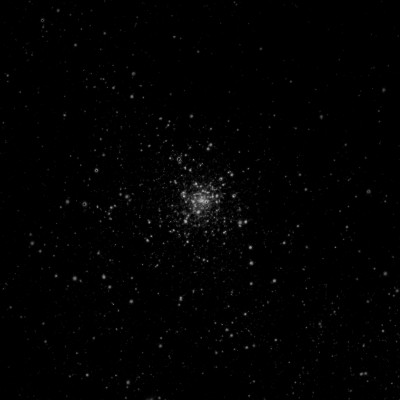
William Herschel discovered NGC 6544 = H II-197 = h1994 on 22 May 1784 (sweep 223) and recorded "pB, pL, iR, r." John Herschel made the single observation "F; L; lE; bM; resolved." It was noted as probably a globular cluster in the 1921 Helwan Observatory lists, based on photographs taken in 1914-16.
200/250mm - 8" (8/23/84): at 200x, appears moderately bright with two stars are visible at the center and two or three stars are resolved at edges. The appearance is grainy with a brighter core.
8" (7/31/81): fairly faint, small, brighter core, easy but no resolution.
400/500mm - 17.5" (5/10/91): bright, 4'x3', elongated NW-SE, irregular and scraggly outline, mottled. Located in a rich star field. About six stars are superimposed including two or three mag 13 stars in a tight knot near the center. In addition, several faint stars are resolved at the edges (or nearby field stars). A double star with components mag 11.5/13.5 lies 2' SW.
600/800mm - 24" (7/30/16): at 260x; bright, moderately large, irregular scraggly halo, ~4'x3' roughly E-W. Well concentrated with a bright irregular core with resolved stars. A mag 11.2 is at the southwest side of the halo, 1.5' from center. Roughly 15-20 stars are resolved in the halo (horizontal branch magnitude ≈ 15.2), though some of these are likely field stars. At least a half-dozen stars are resolved in the central core including a pair of close brighter stars and a third nearly in line. At 375x at least a dozen stars were resolved over an irregular core region.
Notes by Steve Gottlieb
NGC 6520
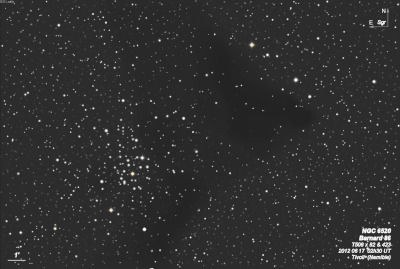
William Herschel discovered NGC 6520 = H VII-7 = h3721 on 24 May 1784 (sweep 224) and recorded "a cluster of stars, chiefly large ones; considerably rich, but rather coarsely scattered; a little more compressed towards the middle. It is visible in the finder." Nearly 5 minutes earlier, he noted "Daylight very strong", though observed a couple more objects.
400/500mm - 17.5" (7/8/94): striking cluster following the remarkable dark nebula B86. Roughly 75 stars are visible in a 6' diameter. The "Inky" black dark nebula B86 to the east wraps around the cluster like a tentacle along the south side and also appears to wind through a large portion of the cluster. In the cluster's core is a very dense perfectly circular group of about two dozen stars in a 1.5' diameter punctuated with the brightest star at the exact center! Enveloping this core is a dark void except for a few stars that break through to the north. Surrounding this irregular dark annulus is a 6' incomplete oval ring formed by six brighter and several fainter stars. Located in a rich star field. Globular clusters Djorgovski 2 lies 21' WNW and NGC 6540 is 37' ENE!
Notes by Steve Gottlieb
NGC 6624
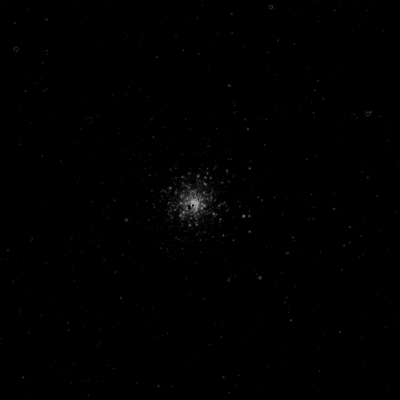
William Herschel discovered NGC 6624 = H I-50 = h3742 on 24 Jun 1784 (sweep 232) and recorded "cL, R, vBM. The brightness appears to be at least 3/4 of the whole visible diameter, but I suppose if the altitude was more considerable a different proportion would be seen. The nebulosity appears to be of the milky kind, but from similar phenomena in low situations, I have no doubt that it is resolvable." JH made three observations from the Cape of Good Hope, first logging on 3 Aug 1834, "Globular Cluster; B; S; R; psmbM; diam 6 seconds in RA; barely resolved so as to be sure it consists of stars." On a later sweep, the cluster was "clearly resolved into stars 16m; a fine object."
400/500mm - 17.5" (5/10/91): bright, fairly small, round, 3' diameter. Very symmetric appearance as increases to a sharp, small bright core and brighter stellar nucleus. There was some resolution in the halo, particularly on the north edge. Approximately six mag 14-15 stars were glimpsed. A close mag 12/14 double star at 10" separation is 1.7' WSW of center. Located 45' SE of mag 2.7 Delta Sagittarii in a rich star field.
Notes by Steve Gottlieb
NGC 6546
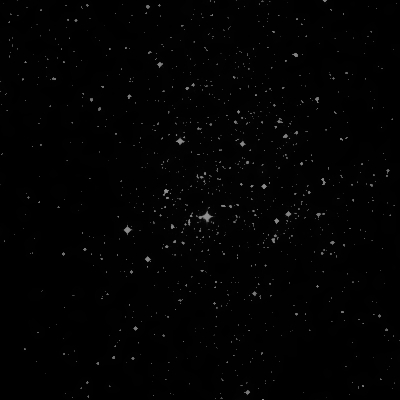
John Herschel discovered NGC 6546 = h3729 on 27 Jun 1837 and noted "the middle of a great and rich cluster in the milky way." The ESO position is about 5' further south.
200/250mm - 8" (8/23/84): scattered group of about 40 stars with 20 stars easily visible and three brighter mag 9 stars on the east side, elongated ~E-W. A mag 8 star is in the field to the NE.
400/500mm - 17.5" (8/27/92): bright, large, scattered, 10' diameter. Including three mag 9 stars on the east side, 10 mag 11-12 stars mag and roughly 70 stars total. Between the three mag 9 stars is a very faint, rich group of 15-20 stars. Near the west edge is a faint, very close double. The majority of the cluster stars are fairly evenly distributed with no other dense regions. Situated in a rich Milky Way field.
Notes by Steve Gottlieb
NGC 6553
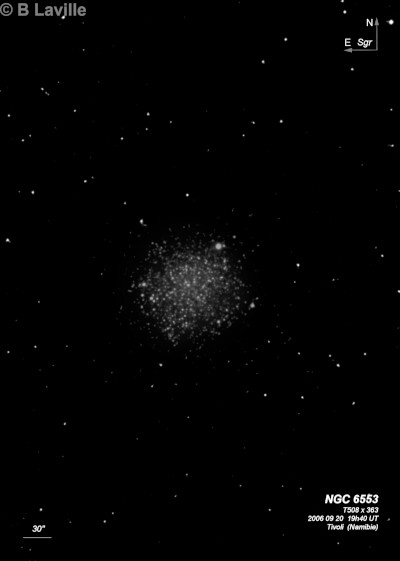
William Herschel discovered NGC 6553 = H IV-12 = h3730 on 22 May 1784 (sweep 223) and recorded "pB, L, difficulty resolving; the nebulosity inclining to milkiness. It is unequally bright." John Herschel called this cluster "globular; vF; a little oval; vglbM; barely r; stars 20m; one * 14m; diam in RA = 7.5 sec." Christian Peters independently found the cluster around 1849 at the Capodimonte Observatory in Naples and claimed it did not appear in any catalogue.
Pietro Baracchi observed the cluster on 5 Oct 1885 with the 48" Melbourne telescope and wrote "pB, pL, irr shape, gbM, a little elongated 150°, 90" long, 60" broad. Resolvable into extremely minute stars. A multitude of small stars in the field."
200/250mm - 8" (7/31/81): fairly bright, moderately large. A single star is at the north edge, elongated or fan-shaped N-S, no resolution.
400/500mm - 17.5" (6/6/86): grainy, mottled globular with a single bright star at the north edge and four or five additional stars at the edges may also be resolved members. Located in a rich field. The brightest member star is V = 14.7.
600/800mm - 24" (7/30/16): at 260x, moderately bright and large, ~3' diameter, weak concentration with no well defined core. A mag 11.8 star is on the northwest side of the halo and fainter stars are on the northeast side (pair) and southwest side, bounding the cluster into a somewhat rectangular appearance. At 432x, the cluster was very lively or mottled with a couple of additional resolved stars and others just on the verge of resolution. A few additional stars were resolved around the edges of the halo.
Notes by Steve Gottlieb
NGC 6569
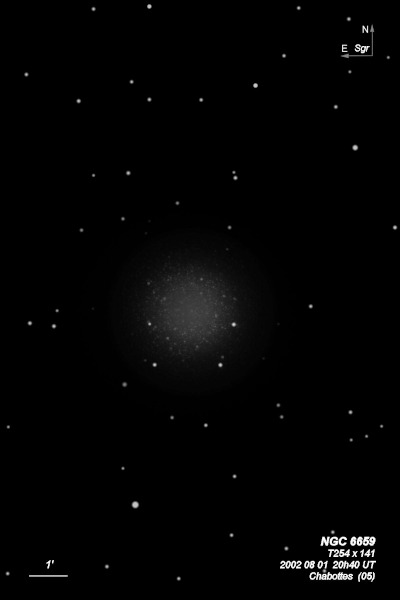
William Herschel discovered NGC 6569 = H II-201 = D 619 = h3736 on 13 Jul 1784 (sweep 237) and recorded "F, pL, lbM, r." His position (CH's reduction) is 9' too far northeast. This globular was the second most southerly object WH discovered. James Dunlop observed NGC 6569 on 2 Jun 1826 and recorded "a pretty well-defined round nebula, about 2' diameter, slight condensation to the centre." He made 2 observations and his position was 14' too far east.
On 3 Aug 1834, John Herschel described the cluster as "globular; pB; L; R; glbM; 4' diam, resolved into stars 15m." He also noted that on 16 Jul 1836, the cluster was "Found in equatorial [5-inch refractor] in a zone review for double stars, where it appeared as a F, R neb 1' diam."
200/250mm - 8" (7/31/81): faint, small, round, no resolution. A mag 7 star is 9' S.
400/500mm - 17.5" (5/10/91): fairly bright, fairly small, round, 2.5' diameter, weakly concentrated but no distinct core. The surface brightness is irregular and the cluster is mottled with darker areas on the east side. But there was no definite resolution into stars. Four stars cradle the globular to the southwest and southeast and mag 6.6 SAO 209873 is 9' S.
Notes by Steve Gottlieb
NGC 6717
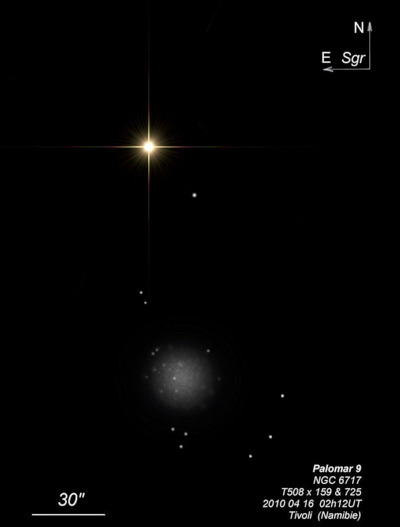
William Herschel discovered NGC 6717 = H III-143 = h2022 = h3766 on 7 Aug 1784 (sweep 245) and recorded "two or three minutes south of 35 Sagittarii are three vS stars which I suspect to contain nebulosity; but it is probably a deception, circumstances are not favourable enough to determine it." His position was accurate. At the Cape of Good Hope on 27 Jun 1837 (sweep 793), John Herschel reported "Close, to the south of, Nu2 Sagittarii; a very small clustering knot, with perhaps nebula. A doubtful object. I see 3 or 4 of the st, but there is also a nebulous appearance."
According to Harold Corwin, Bigourdan's IC 4802, described as "neb *13, 15" nf III 143 [NGC 6717]" refers to a clump of stars northeast of the nucleus of NGC 6717 but part of the cluster. George Abell found the cluster again while inspecting plates for the POSS1 around 1952 and didn't make the connection with NGC 6717. As a result, this globular is also known as Palomar 9!
300/350mm - 13" (6/18/85): fairly faint, very small. This globular appears as a hazy patch easily visible just 1.8' S of Nu 2 = 35 Sagittarii (V = 5.0)! About half a dozen stars are either superimposed or resolved including two close pairs.
400/500mm - 17.5" (7/20/98): very unusual small, faint glow located 2' S of mag 5 Nu 2 Sagittarii! The very faint background glow is ~1' diameter but more notable are several superimposed stars. A close pair of mag 13.5 stars is at the NE edge 25" from center (this is IC 4802!) and a similar star is at the WNW edge 20" from center. A very small bright core appears on closer inspection to be a close pair of mag 12.5 stars or possibly a bright stellar core and nearby star. Other than the central "knot", the unconcentrated 1' background patch has a low surface brightness and is much smaller than the listed diameter of 4'.
600/800mm - 24" (8/23/14): this unusual globular, located just 2' S of Nu2 Sgr, was viewed at 375x and 500x. The "core" appears as a fairly circular, fairly smooth glow, ~1' diameter, with a half-dozen stars superimposed. With extended viewing a very low surface, irregular halo was noticed that increased the diameter to perhaps 2.5'. At the center is an unequal pair oriented N-S (~5" separation), with the southern component, brighter and quasi-stellar. A second pair of mag 14 stars at ~5" separation is on the NE side (this is IC 4802). A mag 16 star is 10" S of this pair. Finally, another mag 14 star is at the WNW side of the core.
Notes by Steve Gottlieb
NGC 6645
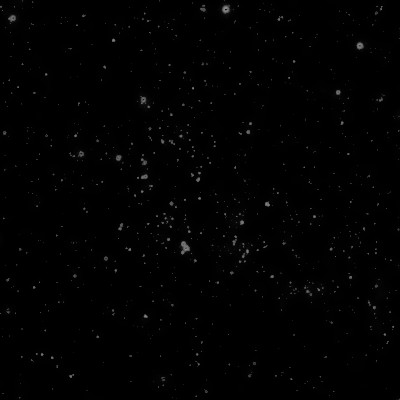
William Herschel discovered NGC 6645 = H VI-23 = h2013 on 27 Jun 1786 (sweep 576) and recorded "a beautiful cluster of vS stars; very rich, the stars are of various sizes and some of them form an almost circular row in the middle. About 15' diameter." John Herschel made a single observation; "a rich, p comp cluster; irreg figure having a vacancy in the middle; stars = 11...15m."
200/250mm - 8" about 50 stars resolved, moderately large, unresolved haze, including a close triple star, rich in faint stars, several dense patches.
400/500mm - 17.5" (8/1/92): at 82x, this is a striking, rich cluster of 20' diameter! Quite rich in faint stars but a noticeable "hole" in center is devoid of stars. A rich knot of stars is on the south side of void and a close triple star is on the north side. A string of stars extends out of the cluster to the east. Three mag 7-8 stars are in the field to the NE. At 220x on the south side of the void are 8 stars in a "V" asterism. Roughly 75 stars are resolved within the central 10' diameter. A rich clump of 8 stars is just resolved at the south edge of the circular hole.
Notes by Steve Gottlieb
NGC 6652
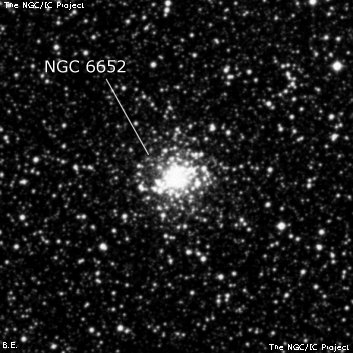
James Dunlop discovered NGC 6652 = D 607 = h3747 with his 9-inch f/12 speculum reflector on 28 Jun 1826. He described "a rather bright well-defined round nebula, about 12 or 14 arcseconds diameter, following a star of the 6th mag." He claims 2 observations and the published position is 33' too far east. The cluster is located 7' SE of a mag 6.8 star, so his identification seems secure, despite the rather small estimated size and poor position.
John Herschel observed this globular on 4 sweeps. On 31 Jul 1834 he logged "B; pmE in parallel; gmbM, 60" long, 35" broad, all clearly resolved." A few nights later he wrote "pB; S; lE; 90" long, 75" broad, stars 15m." On a third sweep he described "vB; S; 40"; resolved. Among close stars, which give it an elongated appearance, but do not seem to belong to it."
Pietro Baracchi observed the cluster on 5 Oct 1885 with the 48" Melbourne telescope and wrote "cB, small, irregular shaped, roundish, small vmbM to a very bright center. Resolvable - cluster of minute stars - yes, a little elongated south-following."
200/250mm - 8" (7/31/81): moderately bright, small, compact bright core. A mag 13 star is at the SW edge but there was no other resolution.
400/500mm - 17.5" (5/10/91): fairly bright globular cluster, fairly small, slightly elongated E-W, 2.0'x1.5', sharp small bright core with a substellar nucleus embedded. The mottled halo was not resolved except for a mag 13 star 1' WSW of the core near the edge of the halo and a mag 14 star at the east edge. Located 7' SE of mag 6.9 SAO 210344.
Notes by Steve Gottlieb
NGC 6568
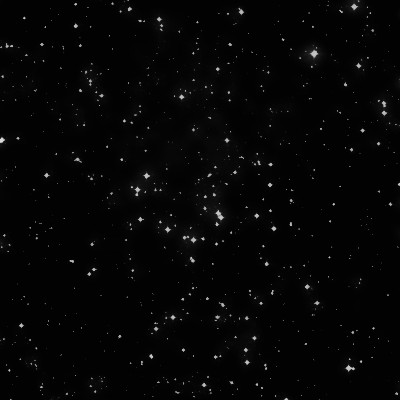
William Herschel discovered NGC 6568 = H VII-30 = h1998 = h3735 on 26 May 1786 (sweep 566) and recorded "a cluster of pS, scattered stars; above 15' diameter." His position is good. From the Cape of Good Hope, JH called this object a "cluster VIII class; loose; scattered; fills field; is decidedly richer than any part of the milky way that has occurred tonight."
200/250mm - 8" (6/27/81): faint, rich dusting of mag 11-13 stars, forms a nice arc. A mag 5.5 star is 30' SE.
400/500mm - 17.5" (8/1/92): at 82x, 75 stars mag 11-14 in 15'x10' region elongated N-S. Appears as a large enhancement of the Milky Way with no sharp edges. Most stars are at the periphery and the central region is devoid of stars. Irregular outline is formed by winding arcs of stars in a "S" pattern with most stars 13th magnitude. The densest region is a very winding lane along the NW edge.
Notes by Steve Gottlieb
NGC 6642
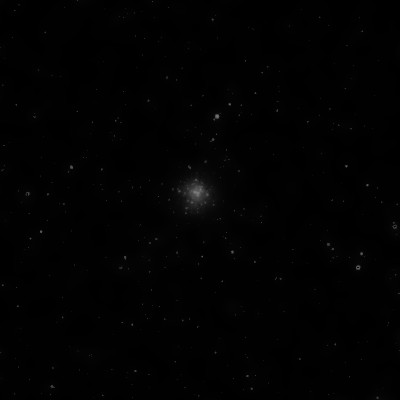
William Herschel discovered NGC 6642 = H II-205 = h2012 = h3749 on 7 Aug 1784 (sweep 245) and recorded "pB, cL, irregularly E, bM." His position is at the east edge of the globular. From the Cape of Good Hope, JH reported (sweep 793) "globular cluster; pB; R; gpmbM; 2'; resolved into visible, but vS stars 15...16m." His position is good. From Slough (sweep 275), he logged "a beautiful little globular cluster of excessively minute stars, 60" diam; seen in twilight. It must be pB when seen in dark sky."
200/250mm - 8" (6/19/82): fairly bright, small, bright core, fainter halo, no resolution.
400/500mm - 17.5" (5/10/91): fairly bright, fairly small, round, 2' diameter, bright core seems slightly offset. Half a dozen mag 14-15 stars are resolved in the mottled halo. A mag 11 field star 2.2' NW and a mag 13.5 star 1.5' NW of center are collinear with the core. Located in a field rich in faint stars.
600/800mm - 24" (8/23/14): at 375x, this fairly bright gc contains a very bright core and an irregular 2' halo. Stars stream out to the east and west creating an impression of elongation. The core is very lively and a few brighter stars are clearly resolved, though packed together very tightly. Roughly 20 stars are resolved in the halo. At 500x, 30-35 stars are resolved (many popping in/out of view) including 8-10 in a clump at the center and close to the core. A single brighter star is just south of the core and a nice pair (~3" separation) is in the halo on the NNE side. A string of stars extends out of the cluster to the north. Easily visible in the 80mm finder at 25x and the finder field contains M22 just 1.1° SE.
Notes by Steve Gottlieb
NGC 6638
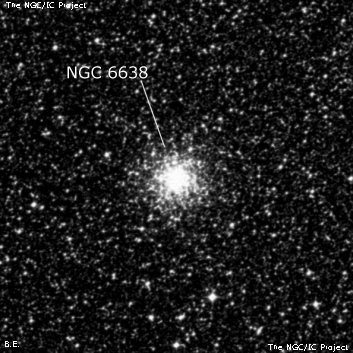
William Herschel discovered NGC 6638 = H I-51 = h3748 on 12 Jul 1784 (sweep 236) and recorded "a pretty cons. easily resolvable R nebula, vBM and faint red perceivable. A second miniature of that near the 42nd Comae [M53]." JH made the single observation "B; S; R; psbM; diam in RA = 4.5s; barely resolved; a very delicate object; doubtless a globular cluster." His position is accurate.
400/500mm - 17.5" (5/10/91): fairly bright, fairly small, round, 2.5' diameter, gradually increases to a bright core. The halo has a fairly even surface brightness. A few extremely faint mag 15-16 stars are resolved at the mottled edges. Located 3.6' N of mag 9.4 SAO 186904.
Notes by Steve Gottlieb
NGC 6528
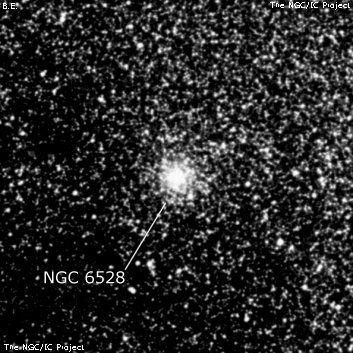
William Herschel discovered NGC 6528 = H II-200 = h3723, along with NGC 6522, on 24 Jun 1784 (sweep 232) and logged "F, pL, unequally bright, r." On 3 Aug 1834, JH recorded "globular cluster, B; R; R; glbM; resolved into stars 16m. Both this and I. 49 NGC 6522] occur on a ground so astonishing rich and stippled over with stars 17m individually discernible, as hardly to admit a pin's point between the stars, and this fills more than the whole field or many fields."
200/250mm - 8" (6/19/82): fairly faint, small, easily visible but no resolution.
300/350mm - 13.1" (6/29/84): fairly faint, small, 2' diameter, not resolved. This is a smaller and fainter version of globular cluster NGC 6522 15' W.
400/500mm - 17.5" (7/11/99): this is the smaller and fainter of an unusual double pair of globulars with NGC 6522 just 16' W. At 220x, it appears round, ~1.5' in diameter. The brightness gradually increased towards the center but there was no distinct core. The surface brightness was fairly smooth overall and the outer halo was fairly well defined. A mag 13.5 field star is at the SW edge. The surrounding field was noticeably more vacant than around NGC 6522. Both clusters can be placed at the edges of the 14' field of the 7mm Pentax XL. Situated within "Baade's Window" (absorption hole in the Milky Way).
Notes by Steve Gottlieb
NGC 6522
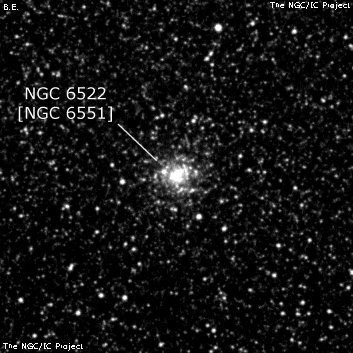
William Herschel discovered NGC 6522 = H I-49 = h3720, along with NGC 6528, on 24 Jun 1784 (sweep 232) and recorded "B, pL, bM, r." John Herschel logged this cluster twice, first recording on 3 Aug 1834: "Globular cluster; pB; S; R; 80: resolved into stars 16m." On a later sweep he logged "GC; B; R; gvmbM; in a nebuloid portion of the milky way; resolved; stars 16...17m."
300/350mm - 13.1" (6/29/84): moderately bright, mottled. A single brighter 13th mag star is on the ENE side. This is the larger and brighter of a pair of globulars with NGC 6528 15' E in Baade's Window.
400/500mm - 17.5" (7/11/99): this globular is the larger and brighter of a fairly faint pair with NGC 6528 in the same field just 16' E. At 220x the halo extended ~2' diameter and contained a very small bright core. A mag 12.5-13 star is embedded in the northeast side. At 280x, the ~25" core appeared offset east of center and the halo was slightly elongated E-W. An unresolved string or bar of stars oriented WNW-ENE (just slightly fainter than the core) appeared to pass through the core . The globular was lively but without distinct resolution. With averted vision the outer haze increased in size to ~3'.
Notes by Steve Gottlieb
NGC 6565
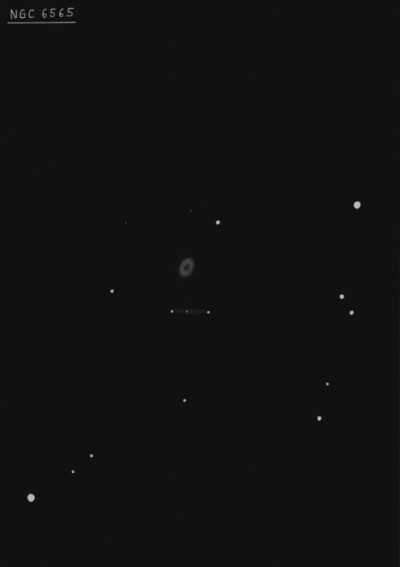
Edward Pickering discovered NGC 6565 = HN 42 on 14 Jul 1880 with the 15-inch refractor at Harvard College Observatory. NGC 6565 was the second of 17 planetaries he found using a direct-vision spectroscope attached to the large refractor. He announced the discovery of the first dozen in Sidereal Messenger, Oct 1882. Compared to NGC 6644, which was discovered the next night, NGC 6565 was "somewhat fainter, but with a larger disk" (The Observatory, 1881).
Based on Crossley photographs at Lick, Curtis (1918) reported NGC 6565 as "a minute oval ring 10"x8" in p.a. about 5°. Considerably fainter along the major axis, and the center is relatively vacant."
300/350mm - 13.1" (8/17/85): at 166x and UHC filter; moderately bright, small, round, clearly non-stellar, 10" diameter, high surface brightness. Easy at 360x without filter, appears slightly elongated NW-SE, no central star visible. Similar view on 8/11/85.
400/500mm - 17.5" (8/17/01): picked up at 100x as fuzzy mag 12 star. At 500x in good seeing, I had an excellent view of a crisp, slightly elongated 10" disc with an irregular surface brightness. In steadier moments, annularity was evident and there appeared to be a tiny darker hole in the center with a brighter rim but no hint of a central star. NGC 6565 is situated within a rich Sagittarius star field with a few faint stars within 1' and several brighter stars in the field.
Notes by Steve Gottlieb
NGC 6578
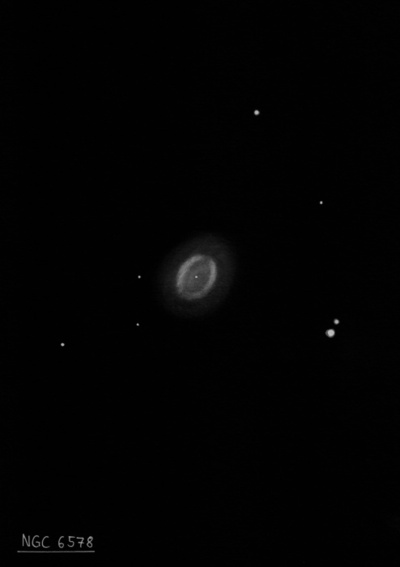
Edward Pickering discovered NGC 6578 on 18 Aug 1882 using a direct-vision spectroscope with the 15-inch refractor at the Harvard College Observatory. NGC 6578 was found on the same night with NGC 6439 and NGC 6567. His RA, though, was 1.5 minutes too small (same error as NGC 6567) and his declination was 10' too far north. The discovery was announced in AN 2459 and Sidereal Messenger, Oct 1882.
Based on Crossley photographs at Lick, Curtis (1918) reported NGC 6578 as "nucleus almost stellar; mag 15. Disk nearly round, 8.5" in diameter; no ansae or structural details discernable."
300/350mm - 13" (6/18/85): just non-stellar at 220x, estimate V = 13.0, 5" diameter. Suspected nebulous at 144x, confirmed by UHC blinking. Located 7.2' NW of mag 7.1 SAO 186575 (17 Sagittarii?). Forms a close double with a mag 11 star 21" WSW and a pair of mag 11 stars is 1' SE. This PN is plotted incorrectly on the Sky Atlas 2000.0.
400/500mm - 17.5" (8/17/01): Situated within a clump of stars at 100x and appeared stellar at low power. At 500x, a small unevenly lit 4" disc was easily visible close ENE [21"] of a mag 11 star. An extremely faint star is just off the SE edge and an evenly matched 20" pair of mag 11 stars lie 1' SE. Located 7' NW of a mag 7 star.
Notes by Steve Gottlieb
IC 4673
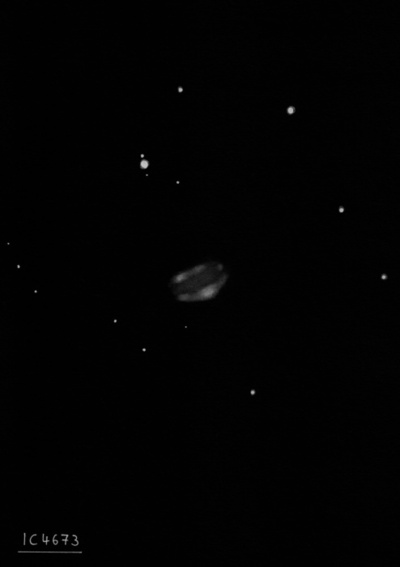
E.E. Barnard visually discovered IC 4673 on 19 Aug 1895 while making measures of the diameter of Ceres with the 36-inch Lick refractor. He described it as "round, slightly ill defined, of uniform brightness and no central star. The measured diameter of this object was 13.6". I should class it as being of the 13th magnitude."
400/500mm - 17.5" (7/5/86): at 220x appears fairly bright and a small round disc is clearly visible about 20" diameter. Prominent with a Daystar 300 filter and a slight oval shape is discernable at 286x and a UHC filter. Estimate V = 12.5.
600/800mm - 24" (7/11/18): at 200x; moderately bright, fairly small, roundish disc in a rich star field. Very good contrast gain using a NPB filter. Excellent view at 375x; irregularly round, slightly elongated ~NW-SE, slightly clumpy rim. Situated 30" of a mag 12 star that forms the southwest vertex of a small "Keystone" asterism. A 7" pair of stars is 2' WSW with a third wider star to the north. No central star visible.
Notes by Steve Gottlieb
NGC 6589
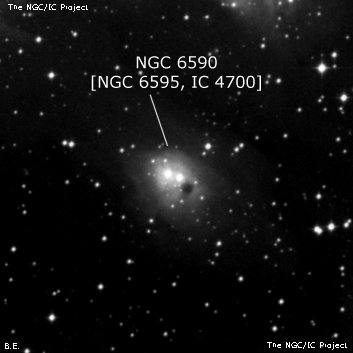
Truman Safford discovered NGC 6589 = Sf 81 = Sw. II-63 on 28 Aug 1867 and noted "10m [with] pF nebulosity." His position is 2.6' too far north, but accurate in RA. Lewis Swift independently discovered this reflection nebula on 12 Jul 1885 and recorded "Another D in center of an eF, pL nebulosity; np of 2 [with NGC 6590]. Except for the inequality of the stars and the excessive faintness of the nebula, it would resemble the preceding [Sw II-62 = NGC 6590]." Swift's position was 35 seconds of time too far west (same error as NGC 6590, found the same night). As Safford's discovery list was not published until 1887 when Dreyer had already compiled the NGC table, Swift was credited with the discovery. E.E. Barnard measured an accurate micrometric position, which was published in AN 3101 and repeated in the IC I Notes section.
Finally, Harold Corwin suggests that Barnard's IC 4690 may a duplicate entry. In "Some notes on nebulae and nebulosities" (AN 4239), Barnard writes "The two stars BD -19d 4881 and -19d 4946 are closely and densely nebulous. The nebulosity about -19d 4881 is somewhat extended nf and sp." BD -19d 4881 is not involved in any nebulosity, but Corwin suggests he meant BD -19d 4940 instead, and the extended nebula should read -19d 4946. If that's the case, then IC 4690 = NGC 6589 and IC 4700 = NGC 6590.
300/350mm - 13" (7/16/82): very faint, larger than NGC 6590 to the south. Surrounds two stars. IC 1283/1284 lies just NE.
400/500mm - 17.5" (8/18/01): at 100x (unfiltered) this is a bright, roundish glow, ~4' diameter, surrounding a wide pair of mag 10/11.5 stars. On the following side, a small 1' glow seems overlapping, causing the east side to bulge out and extending the diameter to 5'x4'. Forms a prominent pair with NGC 6590 6' SSE in a weakly luminous Milky Way field.
17.5" (6/20/87): at 88x with UHC filter appears as a bright, prominent nebula surrounding a mag 9 star. The nebulosity is more extensive on the following side of the star. Forms a pair with reflection nebula NGC 6595 7' SSE.
Notes by Steve Gottlieb
NGC 6567
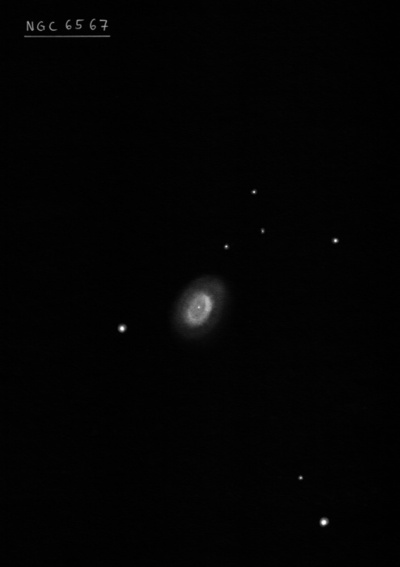
Edward Pickering discovered NGC 6567 on 18 Aug 1882 using a direct-vision spectroscope with the 15-inch refractor at the Harvard College Observatory. NGC 6567 was the 9th of 17 planetaries he found using this technique. His RA, though, was 1.5 minutes too small. The discovery was announced in AN 2459 and Sidereal Messenger, Oct 1882.
Based on Crossley photographs at Lick, Curtis (1918) reported NGC 6567 as "an oval dic, growing rapidly brighter toward the center; 8"x5" in p.a. 150° in the shorter and about 11"x7" in the longer exposures. Exceedingly faint ansae are suspected in the prolongation of the major axis, making the total length 20", but these may be very faint stars..."
200/250mm - 8" (8/15/82): appears as a mag 11 "star" at 100x. Slightly non-stellar at 200x. A slightly elongated disc N-S is visible at 400x. Forms a close pair with a mag 12 star just east. Situated in a rich star field.
400/500mm - 17.5" (7/8/94): bright very compact planetary at 220x with a mag 13 star at the east edge. Excellent contrast gain with OIII filter. A high surface brightness small disc is visible at 280x that is cleanly resolved from the following star. Has a brighter center but no central star seen. Located in a very rich Milky Way field on the SW side of the Small Sagittarius Star Cloud (M24).
Notes by Steve Gottlieb
NGC 6530
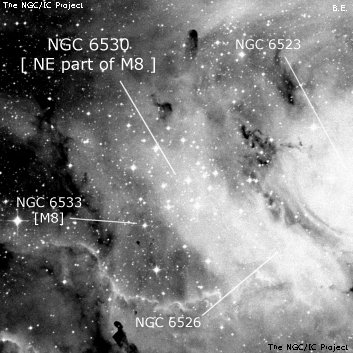
Giovanni Hodierna discovered NGC 6530 = h3725, the cluster within M8, around 1654 and reported it in his catalog "De Admirandis Coeli Caracteribus". Messier described "a cluster of stars that appears to be a nebula when observed with a simple three-foot refractor; with an excellent instrument, however, one sees only a large number of faint stars. Near this cluster there is a fairly bright star [9 Sgr], which is surrounded by a very faint glow." John Herschel recorded (sweep 474) "a B, p Rich, irreg R cl; place that of a double * in the following part of the cluster, which is itself involved in the great nebula M8."
200/250mm - 8" 30 stars mag 7-13 in a 10' diameter. Bright, moderately large. Located on the east edge of M8!
400/500mm - 17.5" (7/8/94): bright scattered group of 40-50 stars at the east edge of M8 just following the edge of the dark "Lagoon" lane which runs SW-NE. The group forms a rough triangular outline 10'x6' oriented N-S with the longest base along the east side running N-S. The cluster is encased in the fairly bright eastern portion of the M8 nebulosity that passes directly through most of the cluster.
Notes by Steve Gottlieb
NGC 6595
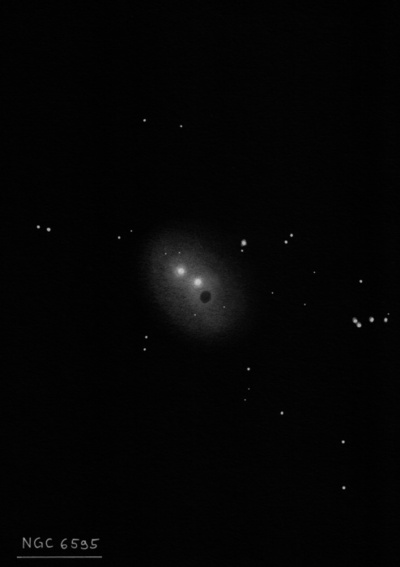
John Herschel discovered NGC 6595 = h2002 on 14 Jul 1830 and recorded "a double * h2827, involved in a pB large nebula 50". See description of that star." He reobserved this object the next two nights as well as sketched it. The RA was only measured on one sweep, but his position and description clearly apply to the bright RN surrounding the double star h2827.
Lewis Swift independently found this reflection nebula on 12 Jul 1885, though his position for Sw. II-62 = NGC 6590 was 45 seconds of RA too far west. Barnard also mentioned that the central star (BD -19°4946) was densely nebulous in AN 4239 and the nebula also received the designation IC 4700. Dreyer missed the equivalence with the previous NGC identifications, but NGC 6590 = NGC 6595 = IC 4700 (see NGC 6590 for more).
Sky Catalogue 2000.0 labels the nebula as NGC 6590/6595 and NGC 6595 is also catalogued as an open cluster at the same position (from Lynga). The RNGC has an error in declination, placing NGC 6590/6595 9' too far south.
300/350mm - 13" (7/16/82): moderately bright, small, surrounds a closely matched double star.
400/500mm - 17.5" (8/18/01): at 100x, this reflection nebula appears as a bright, round glow surrounding a similar pair (h2827) of 10th magnitude stars separated by 20". The glow is fairly large, extending roughly 4' in diameter. Forms a similar pair of RN with NGC 6589 6' NNW. The entire field is weakly glowing and this nebulosity is connected to the large region IC 1283/84 to the NE. A dark patch or globule on the NW side was not seen with certainty.
17.5" (6/20/87): at 88x with UHC filter appears as a bright, prominent nebulosity surrounding a pair of mag 10 stars. Similar or slightly larger than NGC 6589 in field 7' NNW.
Notes by Steve Gottlieb
NGC 6716
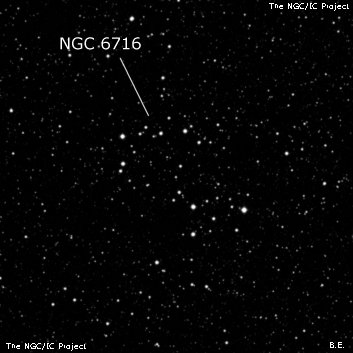
John Herschel discovered NGC 6716 = h2021 on 14 Jul 1830 and recorded "a p rich cluster, figure like the letter S, 7' in extent. Stars 9...13m. Counted 40 of them." His position is accurate.
200/250mm - 8" 20 stars mag 10-13 including a row of stars at the north edge.
400/500mm - 17.5" (5/10/91): about 40 stars visible in a 9' diameter, bright, fairly large but scattered. Divided in two groups; the SSW group includes a mag 8 star and two mag 10 stars. A mag 9 star is at the NE edge of the NNW group, which also includes several mag 10-12 stars in a curved arc. Pretty empty between these two groups with just four stars in the center. Not very impressive.
Notes by Steve Gottlieb
NGC 6647
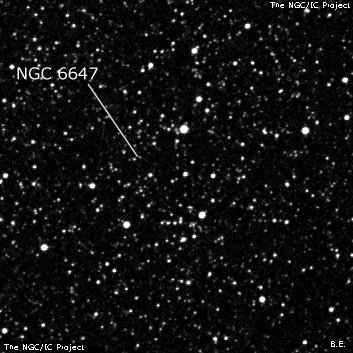
William Herschel discovered NGC 6647 = H VIII-14 = h2014 on 18 Jun 1784 (sweep 230) and recorded "A cluster of scattered stars filling the field; not rich and stars less than those in the foregoing [M25]." There is no significant clustering at his position on the DSS. JH made the single observation "a very loose parcel of very small stars, hardly noticeable as a cluster." His position is ~7' further east-southeast, but again there is nothing noticeable.
Harold Corwin identifies this number with a Milky Way field (unknown size) centered about 3' north-northeast of WH's position. RNGC classifies the number as a nonexistent cluster. See his identification notes for more.
600/800mm - 24" (7/7/13): patchy Milky Way star cloud at 125x (50' field). Unimpressive and does not stand out from the surrounding region except the position is centered on a scattered group of a half-dozen mag 10-11 stars, spread out over 7' in a SE to NW orientation. Located ~23' SSE of the rich open cluster NGC 6645.
Notes by Steve Gottlieb
NGC 6469
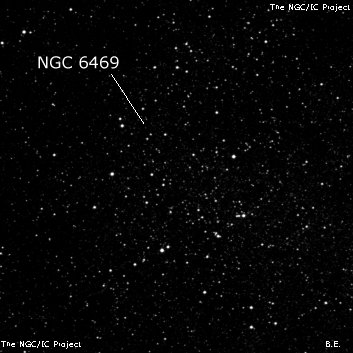
At 105x with an OIII filter, M 1-31 appeared as a faint but easy stellar object, estimate V = 14.5-14.8. It was just visible unfiltered and the filter provided an excellent contrast gain.
John Herschel discovered NGC 6469 = h3711 on 27 Jun 1837 and recorded "a pretty rich insulated milky way cluster; place of a coarse double star in it. The milky way hereabouts is very poor."
400/500mm - 17.5" (8/27/92): 75 stars in a 15'x10' scattered region. Bordered by two brighter rows of stars oriented SSW-NNE and WNW-ESE that intersect at a mag 10 star in the west corner of the cluster. A close faint double star is just east. At the end of the ESE string is a wide double star (h4990 = 9.5/11 at 23"). Between the two strings the cluster extends north forming a triangular outline and consists mainly of mag 13 stars except for three mag 10-11 stars at the east boundary. The planetary nebula M1-31 is located near the west edge of NGC 6469!
Notes by Steve Gottlieb
NGC 6558
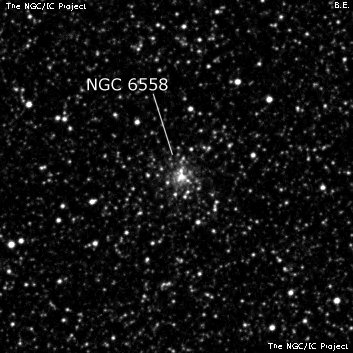
John Herschel discovered NGC 6558 = h3731 on 3 Aug 1834 and recorded "globular cluster; not vB; R; glbM; 2'; resolved. The stars barely discernible." On sweep 794 (June 1837) he logged "globular; pB; irreg R; gmbM; composed of st 16m, on a milky way ground of mixed L and vS stars." This object may be a compact open cluster.
Pietro Baracchi observed the cluster on 5 Oct 1885 with the 48" Melbourne telescope and wrote "pB, pS, round, gbM, resolvable clluster of very minute stars. A multitude of small stars in the field." It was described as "probably be classed as a globular" in the 1921 Helwan list (based on photos taken in 1914-16).
200/250mm - 8" (7/31/86): faint, small, round, six faint stars lie to the south.
400/500mm - 17.5" (7/29/92): moderately bright, small, 1.5'-2.0' diameter, irregular outline. Has a fairly smooth halo with a small bright core offset to the north side with a stellar nucleus sometimes visible. Five or six very faint mag 14.5-15 stars are embedded within the halo. Located in a rich star field.
Notes by Steve Gottlieb
NGC 6440
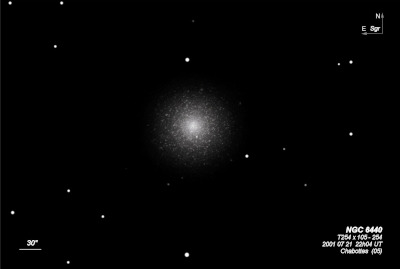
William Herschel discovered NGC 6440 = H I-150 = h1985 on 28 May 1786 (sweep 569) and recorded "cB, R, vgmbM, about 1 1/2' diameter."
Based on early Crossley plates of the region, Heber Curtis wrote a note in 1918PASP...30..161C titled "A Spiral Nebula in the Milky Way." He stated "The nebula NGC 6440 appears to form practically the only known exception to this rule [that spiral nebulae are never found in the Milky Way itself]. Although this object is some distance from the center of all available Crossley plates of this region, rendering its details somewhat indistinct, there seems to be no doubt that it is a rather bright, nearly round, very compact, spiral nebula 1.5' in diameter. Its unusual interest lies in the fact that it is less than 2° from the galactic plane." Before this erroneous note was published a footnote was added stating another plate was taken and "the probabilities are that it is a compact star-cluster showing evidences of spiral formation." Based on photographs taken at the Helwan observatory in 1919-20, the description also reads "some indication of the stars being in spiral formation".
300/350mm - 13.1" (6/29/84): moderately bright, small, broadly concentrated to a brighter core, no resolution. Forms a striking pair with planetary NGC 6445 20' NNE. Brightest member stars are only V = 17.
400/500mm - 17.5" (7/14/99): this globular forms an unusual pair with planetary NGC 6445 just 21' NNE and is situated within a string of four mag 11-12 stars oriented NW-SE. It appears fairly faint, round, at least 2' diameter. At 280x the diffuse halo increases to a moderately bright, round core. Although the globular appears granular, there was no resolution in good seeing except for a very faint star that was intermittently visible off the north edge of the core.
600/800mm - 24" (8/14/15): at 375x; bright, relatively small globular, sharply concentrated with a very bright core and a much fainter, well-defined circular halo, roughly 2' across. The core was mottled and very granular but unresolved. NGC 6440 is collinear with an 11' string of four mag 11-12 stars extending from NW to SE, barely fitting in the field, with the closest star 1.7' NNW of center. At 500x, a few extremely faint stars were resolved in the halo. The bright core contains a handful of resolved stars (mag 16.5 or fainter) that popped in and out of view over the extremely granular background.
NGC 6440 is a highly obscured, metal-rich globular at a low galactic latitude, so resolution is quite difficult.
Notes by Steve Gottlieb
NGC 6540
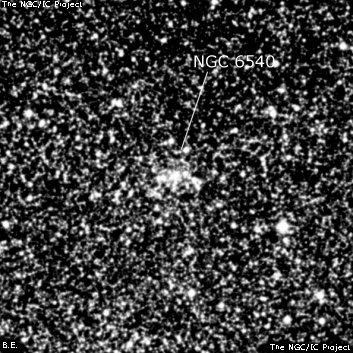
Originally listed as an open cluster, this object was reclassified as a globular in 1987 by Djorgovski.
William Herschel discovered NGC 6540 = H II-198 on 24 May 1784 (end of sweep 224) and recorded "pF, crookedly extended easily resolvable nebula; or rather a cluster of very close stars; not large."
Guillaume Bigourdan's description mentions a size of 1.5' x 25", elongated E-W, stars mag 13 and fainter containing possible "nebulous material". So, Bigourdan was clearly describing the entire string of stars.
300/350mm - 13.1" (9/3/83): very faint, small, rich spot, slightly elongated E-W, mottled but no resolved. Also a group of six faint stars in an arc to the SE. Dark nebula B86 lies 41' W.
400/500mm - 17.5" (7/10/99): this interesting globular is located nearly midway along a short 1.5' E-W arc of a half dozen or so mag 13-14 stars that are bowed out to the north. The globular is a faint, round, 40" glow, embedded just inside the center of this string which extends beyond the globular to the west and east. At 100x, this string, along with the haze of the cluster creates the impression the globular is quite elongated.
Notes by Steve Gottlieb
NGC 6507
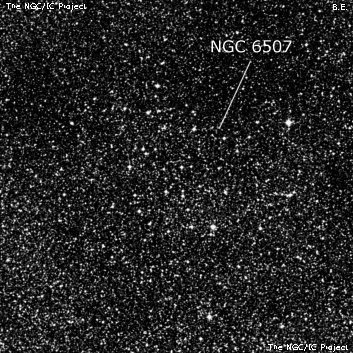
William Herschel discovered NGC 6507 = H VIII-53 on 27 Jun 1786 (sweep 576) and recorded "a cluster of scattered small stars; about 8' diam; not very rich. His position is ~3' too far north. The position in the Gosta Lynga catalogue (and other modern sources such as the RNGC) is ~5' too far northwest.
400/500mm - 17.5" (6/8/91): about 30 stars mag 13-14 in a 7' diameter elongated N-S. Loose appearance with no dense spots. Stars are fairly uniform in brightness. The brightest member is variable WX Sagittarii (9.6-11.3) just west of center.
Notes by Steve Gottlieb
NGC 6644
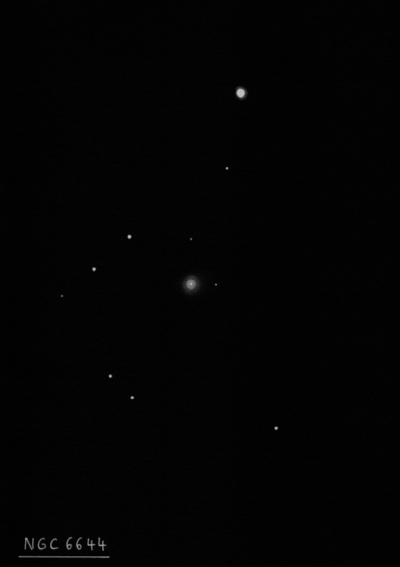
Edward Pickering discovered NGC 6644 on 13 Jul 1880 (Sidereal Messenger, Oct 1882) with the 15-inch refractor at Harvard College Observatory. This was first of 17 planetaries he found using a direct-vision spectroscope (15 new discoveries in the NGC). Pickering noted in The Observatory (1881) that "its disk is so small that it can scarcely be detected with an ordinary eyepiece even if brought into the field of view."
Based on Crossley photographs taken at Lick, Curtis (1918) reported "this object is indistinguishable from a star on the Crossley negatives, but visual observations made by Mr. Moore and Aitken with the 36-inch refractor show that it is a minute disk 2" to 3" in diameter."
400/500mm - 17.5" (8/1/86): bright bluish "star" at 105x that brightens dramatically with OIII blinking. A mag 12 star (good for blinking comparison) is 1.0' N. At 286x, a small disc is visible about 3" or 4" diameter. Estimate V = 11.0.
Notes by Steve Gottlieb
IC 4776
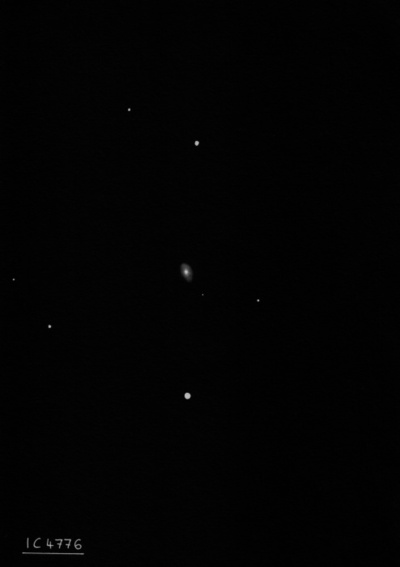
Williamina Fleming discovered IC 4776 = Fleming 77 on a Harvard objective prism plate taken in 1896 at the Arequipa station.
Based on Crossley photographs, Curtis (1918) reported "No true central star can be made out. It is just distinguishable from a star, with wing in p.a. 24°; the length along this axis is 8". No wing is apparent on the opposite side."
400/500mm - 17.5" (8/2/86): at 105x appears bright and stellar, verified with OIII blinking. Forms a wide 1' pair with a mag 13 star to the south. A mag 11 comparison star for blinking is 6' ESE. Good contrast gain with filter, extremely high surface brightness, estimate V = 11.0. At 286x, a small bluish disc is visible unfiltered. Located 12' ENE of a wide bright double star (7.7/9.5 at 45").
Notes by Steve Gottlieb
NGC 6563
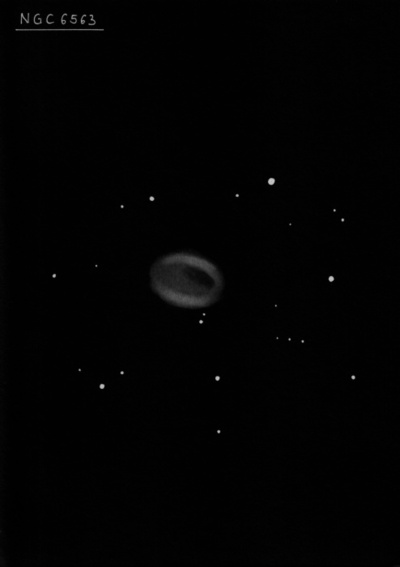
John Herschel discovered NGC 6563 = h3734 = D 606? on 7 Jun 1837 and recorded "a L, F, oval, planetary nebula, about 60" long, 50" broad, or 55"; considerably hazy, or rather indistinctly terminated at the borders, but not bM; a star 6-7m precedes it, just 1 diameter of the field and nearly in the parallel."
James Dunlop possibly discovered this planetary on 3 Sep 1826 and reported a "faint nebula, about 1 1/4' long and 30" or 40" broad, with a considerable brightness near each end and faint in the middle, resembling two small nebulae joined." His position (single observation) is 36' northeast of NGC 6563. This is a fairly large error, even for Dunlop, but the size is reasonably close.
Joseph Turner sketched the planetary on 30 Jul 1877 with the Great Melbourne Telescope as an oval and "a close double star just touches its south edge."
Based on Crossley photographs at Lick, Curtis (1918) reported NGC 6565 as "a faint oval 50"x37" in p.a. 50°; stronger regions at the ends of the minor axis give it an indistinct ring or shell effect; it is considerably fainter along, and at the ends of the major axis."
200/250mm - 8" (7/16/82): faint, elongated N-S, fairly small.
300/350mm - 13" (8/17/85): observation at 166x and 220x: fairly faint, moderately large, slightly elongated ~N-S, no annularity. Prominent using UHC filter, moderate surface brightness. Located in a rich star field 15' ESE of mag 6.2 SAO 209817.
400/500mm - 17.5" (6/28/00): at 280x this moderately bright PN appears elongated 5:4 SW-NE, ~50"x40". The surface brightness is pretty smooth and no central star was visible. A UHC filter provides a moderate contrast gain. Set is a rich star field.
600/800mm - 24" (7/11/18): at 200x and NPB filter; bright, moderately large, slightly elongated SW-NE, ~50" diameter, crisp-edged, irregular surface brightness, weakly annular, resides in a rich star field. At 375x the elongation was more evident as well as a noticeably irregular surface brightness with slightly darker interior areas. A faint star is at the SSW edge and one or two extremely faint stars seemed to be superimposed.
Notes by Steve Gottlieb
NGC 6629
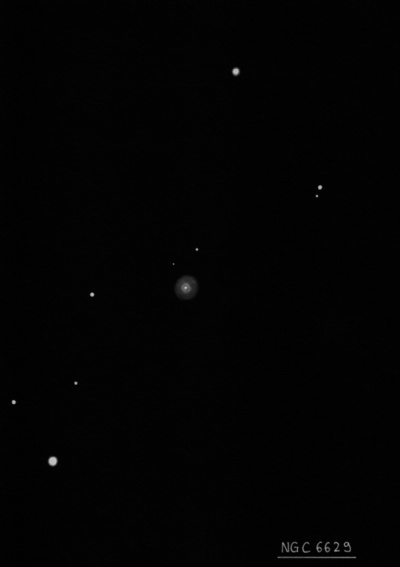
William Herschel discovered NGC 6629 = H II-204 = h3744 on 7 Aug 1784 (sweep 245) and reported "I suspected a pB, S, stellar nebula np a pB star, but there was too much daylight to verify it." John Herschel recorded (sweep 793 from the CGH) "pB; vS; 4" at the utmost in diameter; a good deal furry at the edges, and ? if not a little brighter in the M. It is not a "Stellar Nebula", but rather a link between a planetary and a globular; it probably a v distant and highly compressed globular; has a * 9m 3' dist, sf; night superb and vision perfect. This is one the smallest if not the very smallest nebulous objects I remember to have seen. It is a very remarkable object."
In 1915 Knox-Shaw reported it was a not a globular cluster, but a planetary nebula, based on a photograph taken at the Helwan Observatory with the Reynolds reflector. Curtis (1918) reported "..the central star is about mag 13. The nebular disk is 16"x14" in p.a. 150°, and is nearly equal density throughout, without ansae or other structural details." (Crossley photograph).
400/500mm - 17.5" (8/10/91): at 140x, very bright, small, 15" diameter, round, high surface brightness, crisp-edged. The mag 13 central star is visible with direct vision. Mag 9.4 SAO 186802 lies 2.1' SE. At 280x, the central star is easier to pick out within the high surface brightness nebulosity. A mag 15 star is visible 30" NNW and a mag 15.5 star is right at the NE edge.
600/800mm - 24" (7/11/18): at 375x; bright, small, round, high surface brightness, 15" diameter, sharp edge, bright central star. A mag 15.5 star is barely off the NNE edge (15" from center) and a 15.1 mag star is 25" NW of center.
Notes by Steve Gottlieb
NGC 6537
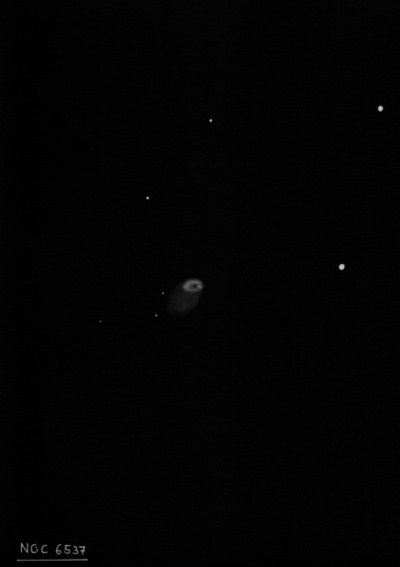
Edward Pickering discovered NGC 6537 on 15 Jul 1882 with the 15-inch refractor at the Harvard College Observatory. NGC 6565 was the 5th of 17 planetaries he found using a direct-vision spectroscope attached to the large refractor. He announced the discovery of the first dozen in Sidereal Messenger, Oct 1882 (no descriptions) and in Astronomische Nachrichten 2454, he noted it as "small and bright". His position in Sidereal Messenger was accurate.
Based on Crossley photographs, Curtis (1918) reported NGC 6537 as "a minute disk 5" in diameter, just distinguishable from a star. Round, with clear-cut edges; a slightly condensation at center is suspected, and a very faint ansa in p.a. 25". The huge hourglass-shapes structure visible in deep images that surrounds the central part was missed in the Lick photographs.
300/350mm - 13.1" (8/17/85): appears mag 12.0 or fainter with OIII filter at 79x. In the field SW of a mag 7 star forming the southern "star" of an arc of three stars.
13.1" (8/11/85): stellar at 166x, estimate mag V = 12.5. Just non-stellar at 220x and clearly nebulous at 360x, about 4" diameter. Appears fainter than computed V magnitude. Located 7' SW of mag 6.8 SAO 161056 and forms the east vertex of an obtuse triangle with two mag 12 stars 1.5' WNW and 2.4' NW.
400/500mm - 17.5" (8/17/01): picked up at 220x as a fuzzy mag 12 "star" forming the eastern vertex of an obtuse, isosceles triangle with two similar stars 1.5' W and 2.4' NW. Excellent view at 380x and 500x. Clearly nonstellar at the higher powers, ~5" diameter with a bluish color and occasionally a slightly brighter center.
600/800mm - 24" (7/11/18): at 225x; very small disc with a warm or ruddy color. Excellent view at 375x; very small, slightly elongated, ~6" diameter. The disc has a very high surface brightness and appears to be surrounded by a very faint thin shell. The PN forms an obtuse isosceles triangle with a mag 11.6 star 1.5' W and a mag 12.6 star 2.4' N.
Notes by Steve Gottlieb
IC 4670
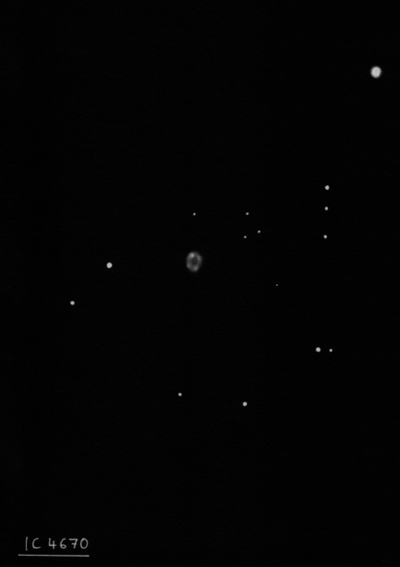
Joseph Lunt discovered IC 4670 visually in 1901 with the Cape Observatory 24-inch refractor (the "Victoria Spectroscopic Telescope" erected in 1898) fitted with an object-glass prism. He described it was stellar and mag 12-13 and situated "immediately S.f. C.P.D. -21[deg] 6502". He noted "The nebula is 2.5 seconds preceding a slightly brighter star of the same declination." It was also photographed on 2 plates in 1901. Although his position is 3.5' too far south, the identification is certain.
Hubble reported IC 4670 as a new planetary after it was found on plates taken in 1920 with a 10-inch Cooke Astrographic Lens with objective prisms attached. The equivalence with IC 4670 was not noticed by the ESO catalogue (1982). Kent Wallace reported IC 4670 = Hb 6 in 1990.
300/350mm - 13.1" (7/12/86): at 79x, faint, stellar, verified with OIII blinking. A mag 11 comparison star is 2.0' NW. At 166x a very small disc is visible which is brighter at the center. The disc is quite clear at 214x, estimate V = 12.5-13.0.
400/500mm - 17.5" (3/20/93): at 220x appears moderately bright (estimate V = 12-12.5) and a very small disc is clearly visible. Good response to an OIII filter. Appears brighter than a mag 13 star 40" E and just fainter than a mag 11.9 star 2.9' E. A double star mag 9.6/11.2 at 7" in PA 163° is 5' SSE.
Notes by Steve Gottlieb
IC 4732
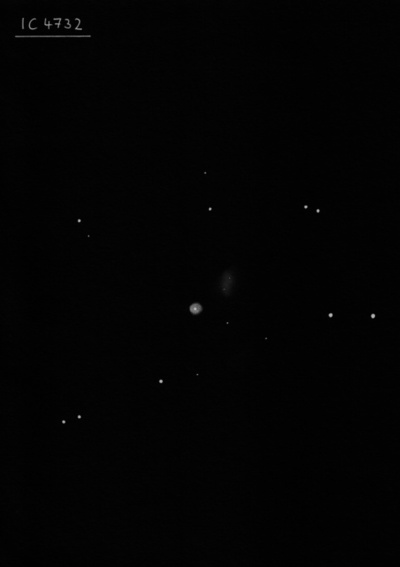
Williamina Fleming discovered IC 4742 = Fleming 99 on a Harvard objective prism plate taken in 1901 at the Arequipa station.
Based on Crossley photographs, Curtis (1918) reported IC 4732 was "indistinguishable from a star on the Crossley negatives, but shown to be minute disk by Mr. Moore and Aitken with the 36-inch refractor."
300/350mm - 13.1" (8/8/86): at 79x appears stellar and verified with OIII blinking, estimate V = 13.0. A brighter mag 10.5 comparison star is located 2.5' W. Appears stellar at 214x. Planetary Pe 1-13 is located 13' ESE.
Notes by Steve Gottlieb
NGC 6439
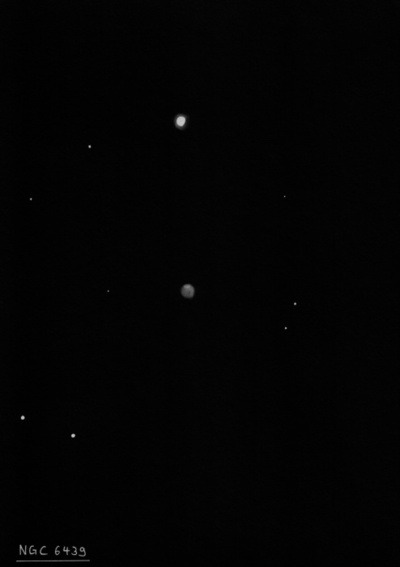
Edward Pickering discovered NGC 6439 on 18 Aug 1882 with the 15-inch refractor at Harvard College Observatory using a direct-vision spectroscope. He reported the discovery in AN 2459 and Sidereal Messenger, Oct 1882 and noted "mag 13. A star, mag 11, north 1' and follows 1 second." His position and description is accurate. Megastar (and probably other sources) misidentify the mag 13 star that is 1' north as NGC 6439.
Based on Crossley photographs at Lick, Curtis (1918) described NGC 6439 as "a minute round disk 5" in diameter, there is a very wind in p.a. 290°. The disk is slightly fainter at the edges."
300/350mm - 13.1" (7/12/86): fairly bright stellar planetary at 79x, verified with OIII blinking. At 166x a mag 10.5 star just 1.2' N is perfectly placed for blinking comparison! Appears stellar at 214x. Estimate V = 12.0-12.5.
400/500mm - 18" (7/25/06): easily picked up at 115x as a quasi-stellar light-blue mag 12.5 "star" just 1' S of a mag 10.4 star. Very good response to the OIII filter. A very small disc was visible at 225x, perhaps 3" in size. Adding a UHC filter this compact planetary was similar in brightness to the mag 10.4 star and appeared to increase slightly in diameter. At 435x a small oval, ~4"x3" was resolved of uniform surface brightness except it seemed to fade around the periphery, hinting at a thin faint envelope. Located in the NW corner of Sgr near the border of Ophiuchus and Serpens Cauda.
Notes by Steve Gottlieb
NGC 6620
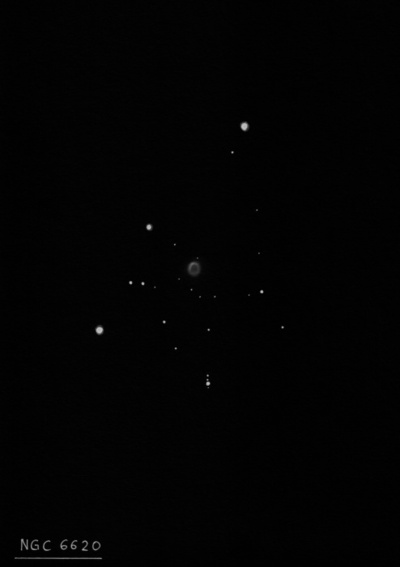
Edward Pickering discovered NGC 6620 = HN 43 on 3 Sep 1880 using a direct-vision spectroscope on the 15-inch refractor at Harvard College Observatory. Pickering noted in The Observatory (1881) this is "the smallest planetary nebula known and could not be distinguished from a 13th magnitude star in an ordinary telescope." His position is exactly 1 minute of time too far west.
Based on Crossley photographs at Lick, Curtis (1918) reported "round; about 5" in diameter; just distinguishable from a star. No structural details can be made out, although faint ansae are suspected in p.a. 70-250°..."
300/350mm - 13.1" (7/12/86): stellar planetary at 79x located 2.1' NW a mag 10.5 star. Verified with OIII blinking. At 214x and UHC filter appears moderately bright and a very small disc about 4" diameter is visible. A mag 13 star lies 0.9' E.
Notes by Steve Gottlieb
IC 1283
E.E. Barnard discovered IC 1283 on the photographic plate taken with the 6" Willard in Jun 1892. He commented that BD -19° 4948 is nebulous and "the nebulosity is very small and principally noticeable on the southern side of the [9.3 magnitude] star." Megastar misidentifies IC 1283 as NGC 6595, which is identical to NGC 6590.
400/500mm - 17.5" (7/26/95): at 100x unfiltered appears as a very faint, very large nebulosity, at least 10' diameter. Encompasses a mag 9 star and extends about 10' NE to merge with IC 1284 surrounding mag 7.6 SAO 161273. The illuminating star is 6' NE of reflection nebula NGC 6589 and 8' NNE of NGC 6590 = NGC 6595.
17.5" (6/20/87): at 88x and UHC filter appears as a very large, extensive nebulous region just NE of NGC 6589 and NGC 6595. Has an elongated, irregular shape. Includes a mag 7.5 star near the north end. IC 1284 is a connected portion.
Notes by Steve Gottlieb
IC 1284
E.E. Barnard discovered IC 1284 on a photographic plate taken with the 6" Willard lends on 31 May 1892. He noted "an unknown nebulous star [BD -19° 4953]. It is shown on the photograph to be nearly symmetrically surrounded with a faint diffused nebulosity about 15' in diameter. Perhaps this nebulosity is a little denser and more extensive following. Visually with the 12 inch, I cannot be certain of seeing the nebulosity on account of the brightness of the central star." He later described nearby IC 1283 in AN 3111. Barnard's position matches the mag 7.6 star involved.
400/500mm - 17.5" (7/26/95): this is the northeastern section of the IC 1283/1284 nebulosity surrounding mag 7.6 SAO 161273. Although brightest around the star, the nebula appears to nearly merge with IC 1283 stretching SW to a mag 9 star located 7' SW. Located less than 15' NE of the bright reflection nebulae NGC 6589 and NGC 6595.
Notes by Steve Gottlieb
Pal 8
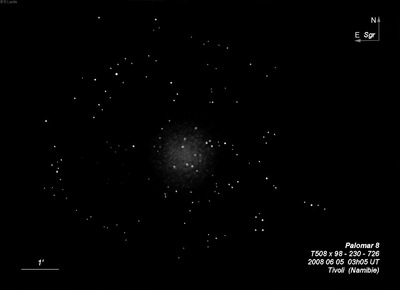
| Type | GC [X] |
| RA | 18:41:30.0 |
| Dec | -19:49:00.0 |
| major_axis | 5.2' |
| mag | 10.9 |
| surface_bright | 14.2 |
HCG 86
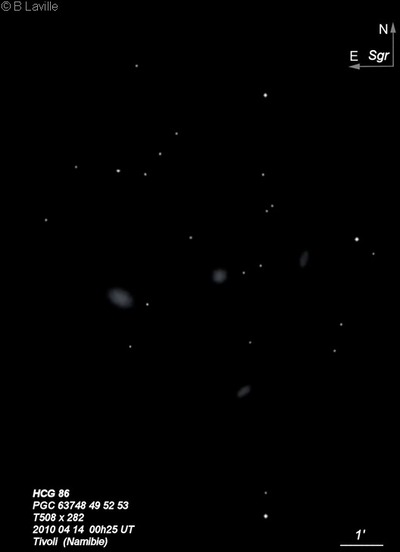
| Type | GALCL [E2] |
| RA | 19:51:59.2 |
| Dec | -30:49:34.0 |
| major_axis | 5.2' |
| mag | 12.3 |
| surface_bright | 99.9 |
M 1-54
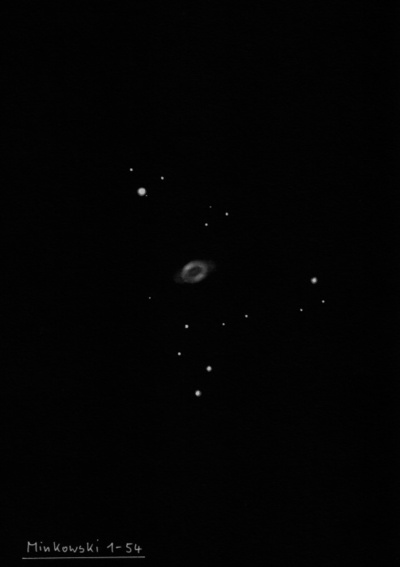
| Type | PN |
| RA | 18:36:08.4 |
| Dec | -16:59:57.0 |
| major_axis | 12.0'' |
| mag | 12.5 |
| surface_bright | 8.9 |
Cn 1-5
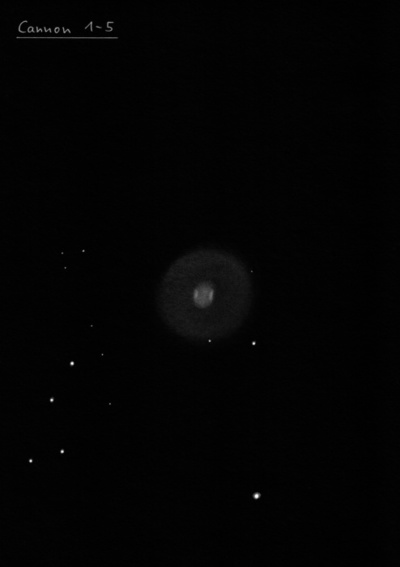
| Type | PN |
| RA | 18:29:11.7 |
| Dec | -31:29:59.0 |
| major_axis | 6.0'' |
| minor_axis | 12.0'' |
| mag | 12.6 |
| surface_bright | 7.6 |
M 1-47
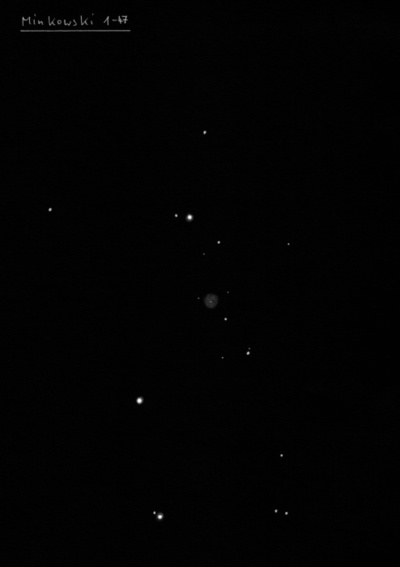
| Type | PN |
| RA | 18:29:11.1 |
| Dec | -21:46:54.0 |
| minor_axis | 48.0'' |
| mag | 13.1 |
| surface_bright | 7.3 |
M 1-53
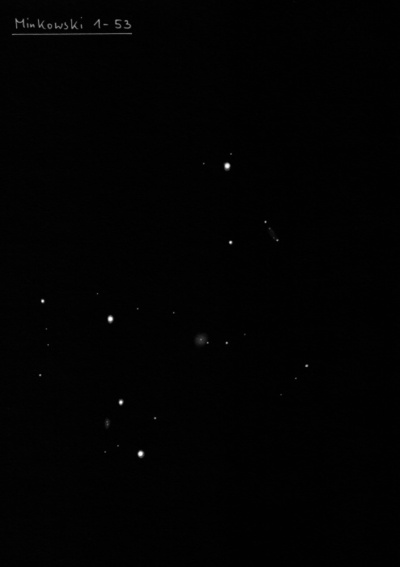
| Type | PN |
| RA | 18:35:48.3 |
| Dec | -17:36:09.0 |
| major_axis | 6.0'' |
| minor_axis | 6.0'' |
| mag | 13.9 |
| surface_bright | 8.6 |
PC 21
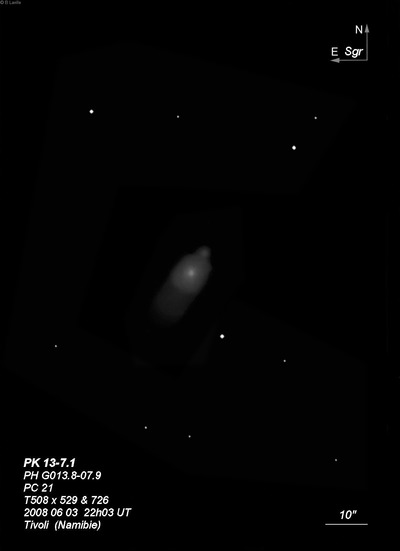
| Type | PN [?(3)] |
| RA | 18:45:35.2 |
| Dec | -20:34:58.0 |
| major_axis | 12.0'' |
| minor_axis | 12.0'' |
| mag | 13.9 |
| surface_bright | 10.4 |
H 1-67
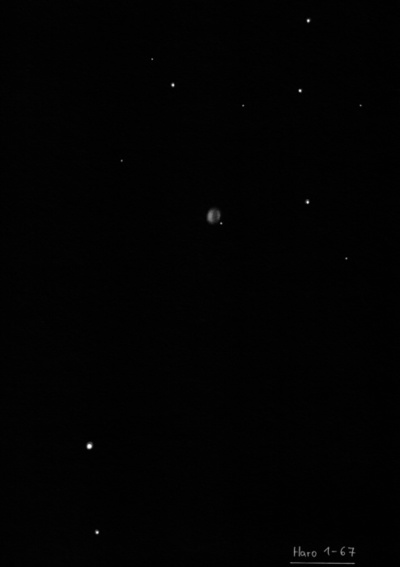
| Type | PN |
| RA | 18:25:05.0 |
| Dec | -22:34:53.0 |
| major_axis | 6.0'' |
| minor_axis | 6.0'' |
| mag | 14.0 |
| surface_bright | 8.6 |
Abell 66
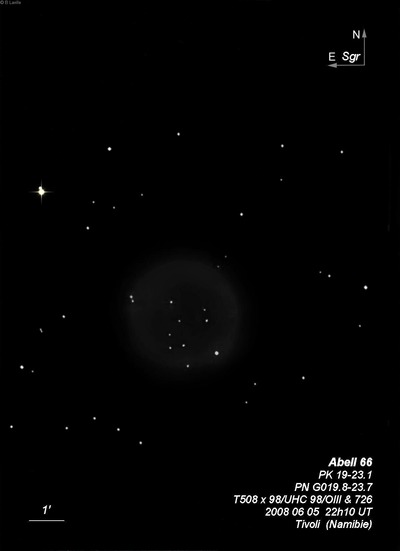
| Type | PN [3b] |
| RA | 19:57:31.5 |
| Dec | -21:36:45.0 |
| major_axis | 4.5' |
| mag | 14.1 |
| surface_bright | 17.1 |
M 3-31
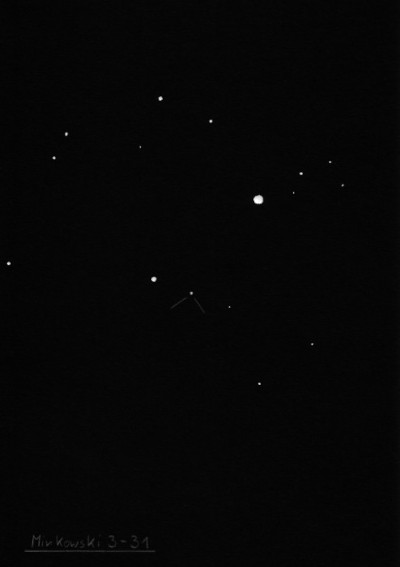
| Type | PN |
| RA | 18:44:01.8 |
| Dec | -19:54:53.0 |
| major_axis | 6.0'' |
| minor_axis | 12.0'' |
| mag | 14.2 |
| surface_bright | 9.2 |
M 2-15
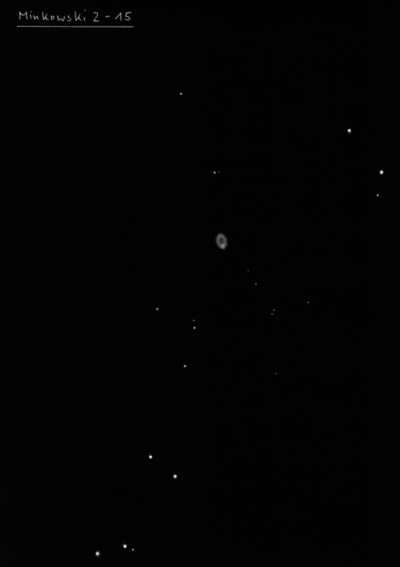
| Type | PN |
| RA | 17:46:54.4 |
| Dec | -16:17:25.0 |
| major_axis | 6.0'' |
| mag | 14.6 |
| surface_bright | 9.2 |
M 2-41
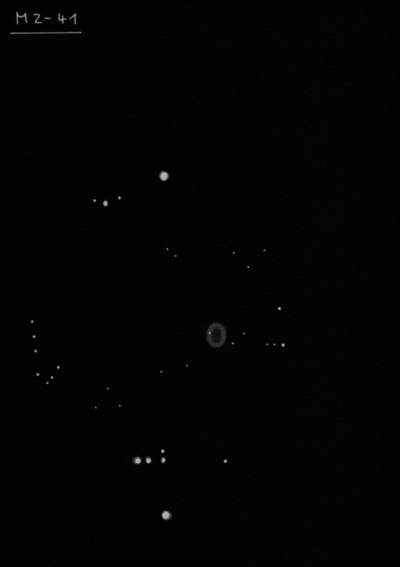
| Type | PN |
| RA | 18:22:34.5 |
| Dec | -30:43:31.0 |
| major_axis | 12.0'' |
| mag | 14.7 |
| surface_bright | 11.3 |
M 1-32
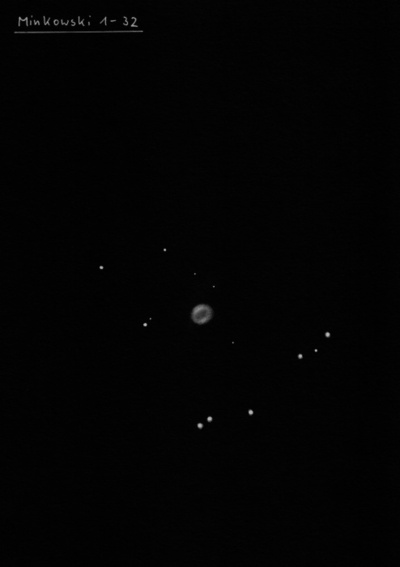
| Type | PN |
| RA | 17:56:20.1 |
| Dec | -16:29:05.0 |
| major_axis | 6.0'' |
| minor_axis | 18.0'' |
| position_angle | 1.0 |
| mag | 15.0 |
| surface_bright | 10.2 |
Abell 65
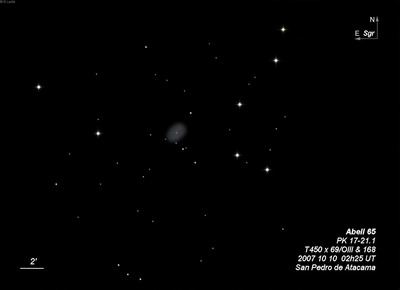
| Type | PN [2a] |
| RA | 19:46:34.2 |
| Dec | -23:08:13.0 |
| major_axis | 2.29' |
| mag | 15.2 |
| surface_bright | 16.8 |
Abell 51
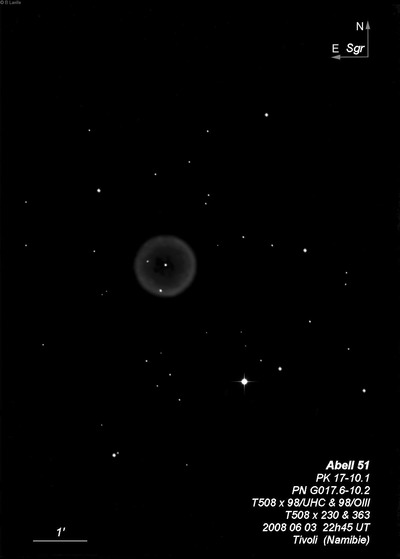
| Type | PN |
| RA | 19:01:01.4 |
| Dec | -18:12:15.0 |
| major_axis | 66.0'' |
| minor_axis | 60.0'' |
| mag | 15.4 |
| surface_bright | 15.2 |
Abell 60
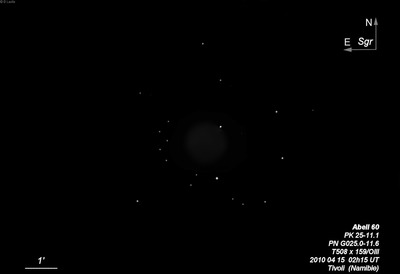
| Type | PN [2b] |
| RA | 19:19:17.8 |
| Dec | -12:14:37.0 |
| major_axis | 78.0'' |
| minor_axis | 66.0'' |
| mag | 15.4 |
| surface_bright | 15.5 |
DeHt 3
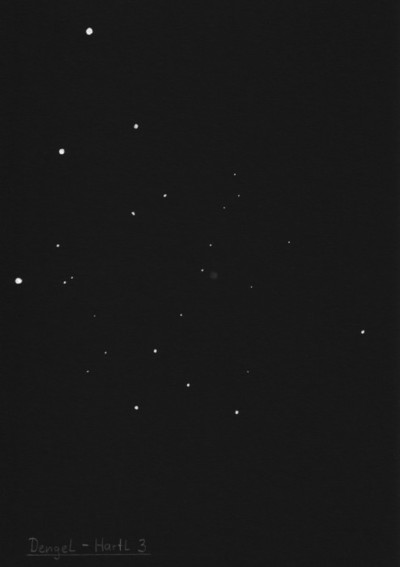
| Type | PN |
| RA | 19:17:04.2 |
| Dec | -18:01:37.0 |
| major_axis | 36.0'' |
| minor_axis | 30.0'' |
| mag | 15.6 |
| surface_bright | 13.9 |
Abell 44
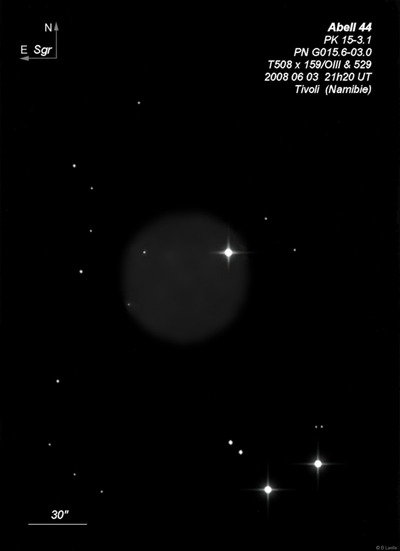
| Type | PN |
| RA | 18:30:11.2 |
| Dec | -16:45:26.0 |
| major_axis | 66.0'' |
| minor_axis | 42.0'' |
| mag | 17.4 |
| surface_bright | 16.7 |
